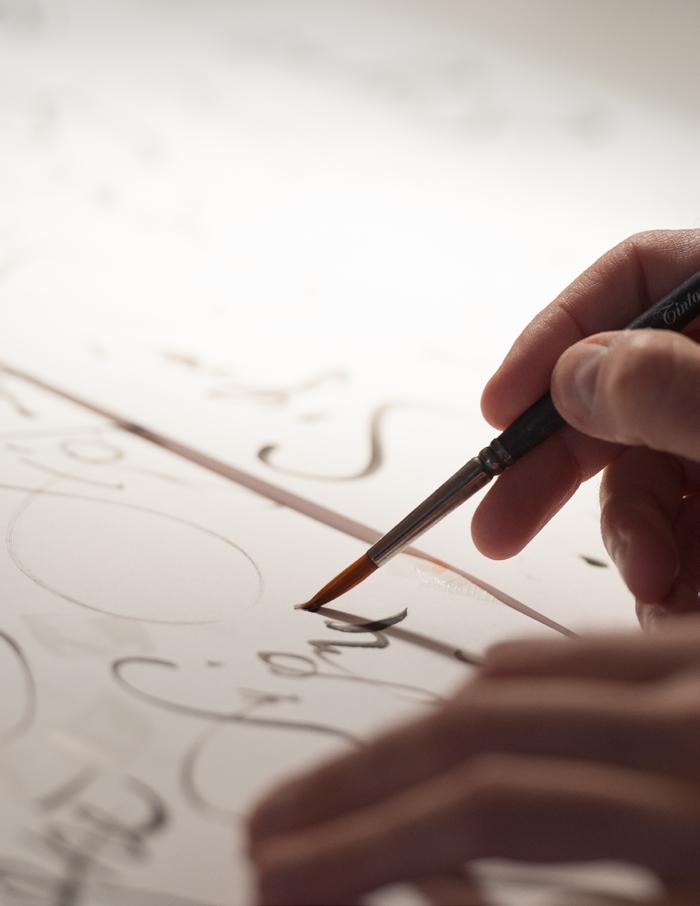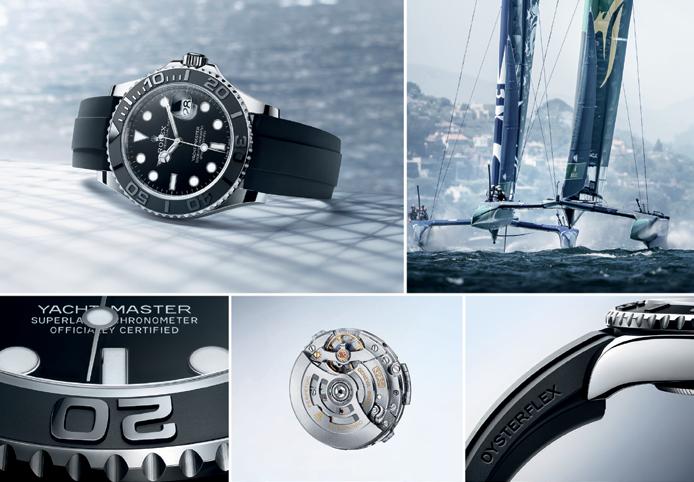


Plush 3 and 4 bedroom homes


With panoramic ocean views from your private balconies to exquisite interiors, indulge in the ultimate luxury of waterfront living.









With panoramic ocean views from your private balconies to exquisite interiors, indulge in the ultimate luxury of waterfront living.




Indulge in the epitome of opulence at Cavalli Couture, where luxury finds its untamed form. A place that embraces your aspirations and desires and offers you a lifestyle that transcends all boundaries.

LUXURY, UNTAMED.
Permit No: 1506353768

Your last chance for a woodland lifestyle


The seventh and final phase of Masaar, Saro is an idyllic retreat that will offers an upgraded lifestyle. 27232
Choose from a range of well-appointed homes, from two-bedroom townhouses to six-bedroom signature villas. Every residence at Saro blends nature-inspired design and features with the latest smart home technology, bringing you environmentally friendly convenience and comfort.



Experience seaside bliss with DAMAC Bay by Cavalli. As the rhythm of waves light the way to this 40-storey treasure, with private beaches, captivating amenities and stunning ocean views, feel a renewed connection to nature and what it means to live in luxury by the sea.


Club, Dubai brings links-style golf blended with culinary excellence well-equipped leisure facilities creates an elegant lifestyle oasis in the U nited Arab Emirates





18-hole championship links-style golf c ourse and a world-renowned and 201 6 Olympic golf c ourse ar chitect, national Dubai is home to the Trump wing studios that offer virtual golf SAM Puttlab technologies, a one-of-a-kind double sided LED floodlit TrackMan driving range, world-class golf facilities, the crescent-shaped with its arching curves and soaring light-filled spaces provides the middle eastern restaurant and luxurious sports well-equipped fitness center a nd an expansive golf pr o exclusive apparel brands in golfing and lifestyle accessories.
In the cover feature of our 50th edition, Maserati teams up with David Beckham to launch the marque’s first Fuoriserie Essentials Collection. Bentley invites its clients to undertake an extraordinary journey, while Rolls-Royce takes sophistication to extraordinary levels with the Black Badge Cullinan Blue Shadow. Mercedes Maybach takes a similar approach with its Night Series. Jaguar reincarnates a legend from its past with a tribute to the first E-Type race wins.


We pick the outstanding “Hublot Lover Art” horological masterpieces from this year. Rolex refreshes its Oyster Perpetual Sky-Dweller. A couple of Patek Philippe blue dial watches make the perfect his-and-hers combo. Chopard continues its support for the 1000 Miglia and launches exclusive timepieces. We discover why Philippe Dufourthe is the master of Simplicity watchmaking.
Gucci’s Horsebeat Society celebrates 70 Years of the iconic Horsebit Loafer, while Berluti introduces four new seasonal patinas for its leather goods. Guerlain upgrades its Aqua Allegoria Forte line with fresh harvests. The Unnamed Society reimagines the Winchester as a clock. We showcase our picks from the Hermès Home collection. We head to the Saudi Kingdom’s Al Ula region to look at The House Hotel’s Dar Tantora. Then we head south to Salalah and find out what Alila Hotel at Hinu Bay has to offer.
As always, enjoy the read!

Rolls-Royce’s
74 VACATION SPIRIT
Loro Piana’s Resort Collection
76
RECALLING ASTURIAS
D&G x Pelayo Diaz Special Collection

80
Mercedes-Maybach’s
ICONIC CELEBRATION
Gucci’s Horsebit Loafer exhibition
84
SHADES OF AUTUMN
Berluti’s new patinas and sneakers

88
FRAGRANT TALES
Maserati’s
Guerlain’s new Aqua Allegoria fragrances




“Hublot Loves Art” collaborations deliver exceptional horological art once again, here is our selection from this year’s offerings thus far.
American contemporary artist Daniel Arsham is Hublot’s newest brand ambassador. Based in New York City, Daniel is known for his works across painting, sculpture, installation, and film. He has frequently explored the concept of time throughout his oeuvre, particularly through his Connecting Time series of works and his iconic Hourglass.
To commemorate the new partnership, Daniel has unveiled a temporary 20-metre sundial in the snowscape of the Swiss mountain resort of Zermatt. Matterhorn, the most recognizable peak in the Swiss Alps forms the backdrop. The installation - titled Light & Time - uses natural elementssnow and light - to “merge the roots of timekeeping with the craftsmanship in land art.”

The choice of Zermatt as the location for the collaboration was not by chance. Zermatt is a Hublot town. The resort carries Hublot signage and keeps time with Hublot clocks. On four occasions since 2017, Hublot has introduced limited-edition watches at its Zermatt boutique.
Arsham’s functioning outdoor timekeeping installation at Zermatt is based on the shadows cast by the quartz crystal-
shaped obelisk. As the sun moves throughout the day, the shadow cast by the central pointer indicates the time in the raked snow. The snow and light sundial echoes Hublot’s design language, integrating familiar cues such as the famous screws that hold the Big Bang’s bezel in place. The installation is only visible from the top of the mountain. To view it, art lovers will have to use the ski lifts.
Commenting on his new installation, Arsham said: “Physically, the temporary installation will capture something of how fleeting time can feel, but it will also be lasting, creating a memory that transcends the passing of the seconds, minutes, hours and days in all those who make the journey up the mountain to see it.”
Arsham also happens to be a long-time admirer of the Hublot brand. “I’ve been watching Hublot and the projects it has supported in the contemporary art space with great interest for many years, and admired its audacious approach to watchmaking, design and craft. The Art of Fusion remains one of the smartest projects in watchmaking. I love how Hublot crafts ideas, influences and materials together to create unique, defining forms.”

The diversity of your collaborations with artists is truly impressive, ranging from Arsham's unveiling Takashi Murakami's Daniel sundial-inspired to integration of NFTs. How does Hublot approacheachcollaborationtoensurethat the essence of the artist's work is authentically captured in the design of the limited-editiontimepieces?
Ricardo Guadalupe, CEO Hublot: Each collaboration takes a special approach because each of our ambassador is unique. The Hublot Loves Art family is a true collaboration where we work hand in hand with the artist. We value these relationships, and this results in a valuable partnership but also a long lasting friendship. We work with talents to create impressive watches with worlds and stories to tell. With each of these artists, whether it is Murakami or Arsham, we are creating a wearable work of art that encapsulates their art within the Hublot DNA. It is a perfect fusion, and it is what makes the watches so authentic, elevating the watch to a new level.
The first Hublot x Takashi Murakami collaboration of the year saw the launch of 13 new Classic Fusion watches that were presented at Watches & Wonders in Geneva. For the first time, these 13 watches were linked to 13 unique NFTs inspired by Japanese video games and TV shows from the 1970s, as well as the Takashi Murakami All Black - the first watch collaboration between the artist and Hublot.
One of these 13 watches is the master watch of the collection: the Classic Fusion Takashi Murakami Black Ceramic Rainbow. Unveiled at an exclusive held at the Glass House in New York on February 2, it combines the aesthetics of the two previous collaboration models, but offers a fresh interpretation of Takashi Murakami’s iconic emblem: the smiling flower.
The 12 petals of the flower in this watch form a circular gradient of rubies, sapphires, amethysts, tsavorites and topaz. The petals create a dizzying spectacle of colour as they spin on an axis with each movement, thanks to an innovative new ball-bearing system developed by Hublot’s engineers. The kinetic effect of the petals creates a striking contrast against the 45mm black ceramic case.
The centre of the smiling flower is placed on top of the sapphire glass to create a three-dimensional effect. Powering all 13 watches is the Unico calibre set in the emblematic Classic Fusion design. It offers 72 hours of power reserve.
The 12 remaining watches feature one of the 12 colours featured on the master watch’s petals; twelve references for the twelve petal colours of the master watch. These 12 watches were available for purchase exclusively on the OpenSea trading platform, which can be accessed only by the owners of at least one of the 324 NFTs issued in April 2022.
As the second step, collectors then have a period of one year during which they will have the opportunity to trade the twelve NFTs on OpenSea. In April 2024, the collector who has managed to collect all 12 of the new unique NFTs will be eligible to purchase the master watch of the collection: the Classic Fusion Takashi Murakami Black Ceramic Rainbow. If no single person manages to gather all twelve NFTs, the watch will be auctioned by Hublot to raise funds for charity.
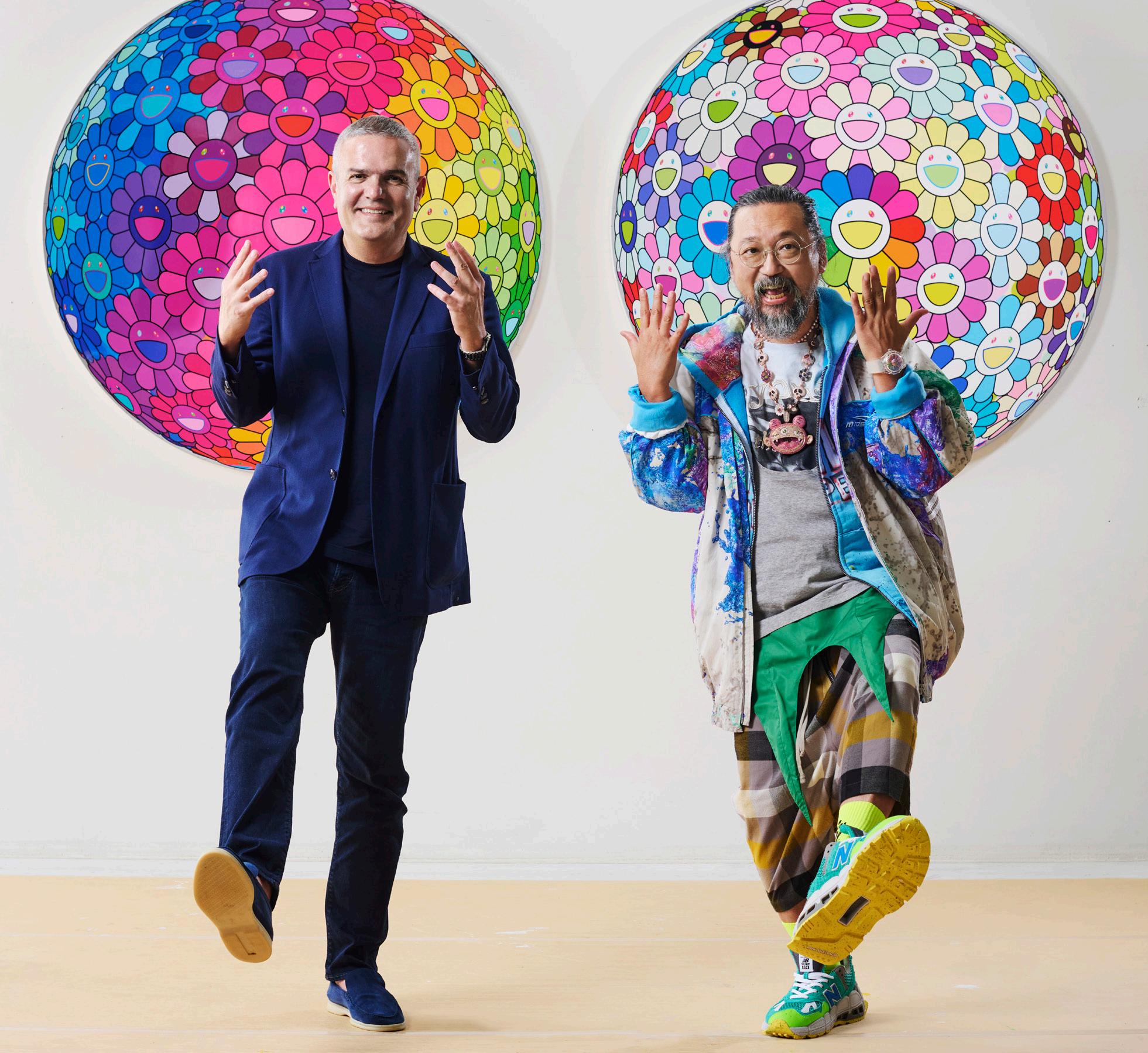

Collaborating with artists like Takashi Murakami involves bridging the gap between traditional watchmaking and the digital realm of NFTs. Could you elaborate on how Hublot navigates this intersection of art, technology, and horology to create timepieces that resonate with both collectorsandartenthusiasts?
Ricardo Guadalupe, CEO Hublot: We are very lucky to work with pioneering contemporary artists like Murakami because we are always adapting to the new changes and the evolution of the art world. Luxury must always reinvent itself! At Hublot, innovation is at the centre of everything we do, and we want to enter a space where others might not dare to go. Art, technology, horology – this is what inspires new ideas and collaborations. By working with Takashi Murakami and collaborating on an exclusive set of NFTs, it’s an added value for our clients. We can give our clients something new and unique, and we would like our products to be a reflection of the new ways we are experiencing luxury.
Hublot and Maxime Plescia-Buchi - the celebrated typographer, tattooist, artist and founder of Sang Bleu design studio – present the Spirit of Big Bang Sang Bleu. The collection comprises three limited editions: 200 in All Black ceramic, 200 units in titanium, and 100 in King Gold. In addition, there are two one-of-a-kind watches in titanium and King Gold, both set with 180 diamonds each weighing approximately 2.4 carats.
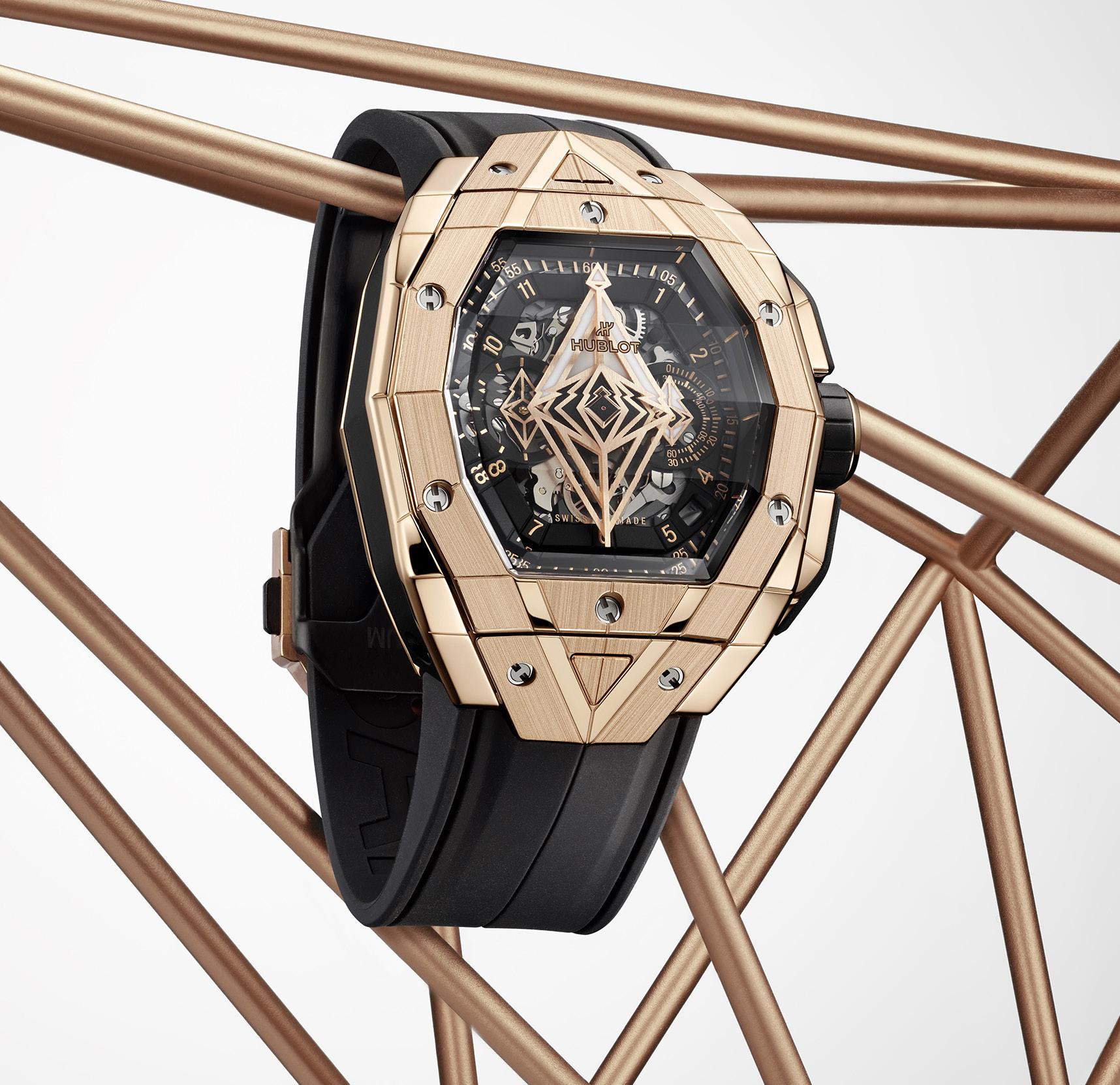
This is the third Hublot x Sang Bleu model to emerge from the collaboration that began in 2016, and the first based on Hublot’s Spirit of Big Bang watch. The previous two were based on the Big Bang models.
Maxime has skilfully transposed his signature lines onto the barrel shape of the Spirit of Big Bang through elongated bevelled features and proportioned angles. Like his tattoos, the line adapts to the case, and he creates relief and depth through polished, satin-finished, engraved, chiselled, bevelled and faceted materials. Hexagons, diamonds and triangles appear and overlap, redefining the shape and volume of the watch.
Despite its generous proportions, the 42 mm case and its seemingly inorganic shape, its case-back and sapphire crystal have been arched at several points to ensure that the watch fits the curves of the wrist. Geometric tattoos alternate and overlap from the case to the bezel. A sapphire dial displays the HUB4700 automatic skeleton chronograph movement. Hovering above it are the “disc” hands bearing the signature geometry of Sang Bleu timepieces. The structure of the hands has been enhanced and the hour and minute markers have been refined when compared to the Sang Bleu II.
“After having made my mark on the Big Bang, my creative process has taken on a new form,” says Maxime. “This is the new collection, and the barrel shape of the Spirit of Big Bang. I have been able to question and review each component, from the case to the crystal, the bracelet to the clasp, considering each shape and proportion through a holistic reflection.”
The Sang Bleu collaboration has now resulted in a third collection, showcasing intricate geometric designs on the Spirit of Big Bang watches. Collaboration evolution is evident here. How does Hublot strike a balance between retaining the recognizable elements of the Sang Bleu partnership while also pushing creative boundaries to deliver freshandcaptivatingdesigns?
Ricardo Guadalupe, CEO Hublot: When working with Maxime, it was a mutual project. We took the time to understand what his art represents, and how he can transpose his art onto the canvas of the watch. It’s what the Art of Fusion is all about. By merging the tattoo work of Maxime and transforming it into a complicated and aesthetically powerful watch, we create something very impactful. For the latest Spirit of Big Bang Sang Bleu, it was a reinterpretation of our iconic codes through Sang Bleu’s aesthetic signatures. Without losing the iconic shape of the Spirit of Big Bang, Maxime gave the watch a new look, with a distinct charisma. With each collaboration, the fusion highlights the best features and unique potential of each design.

In the sixth year of Hublot’s collaboration with renowned French artist Richard Orlinski, the signature sharp angles on the latest Hublot x Orlinski timepiece have become a little softer, the diameter has reduced, while the mechanism’s precision has increased.
“Those who know me know that I am highly demanding and do not impose any limits on myself. It is undoubtedly this shared approach that has united us since 2017. This collaboration is such a success because it is the result of a perfect harmony between innovation and know-how,” says Richard Orlinski
Some will be drawn to the facets created by the signature folds and the iconic angular architecture of the internationally renowned visual artist. Others will be drawn by the mechanics of the Hublot chronograph dial.
The new Orlinski model has the Classic Fusion Chronograph’s HUB1153 automatic movement at its heart for the first time. The
smaller 41mm case fits more snugly on the wrist. The signature dodecagonal shape of the bezel transforms into a polygon.
While the watch can be worn with a black rubber strap, it is the three-dimensional titanium bracelet with its distinctive angular patterns that enables the watch to realise its full potential. The micro-blasted titanium of the case and bracelet give the facets a matt finish, for an added touch of elegance.
“Hublot has always been driven by innovation and a bold sense of design which goes against the grain,” says Ricardo Guadalupe, Hublot’s CEO. “There are many parallels between watchmaking and art, both of which require creativity, passion, determination and boldness. These values come together in this collaboration with Richard Orlinski to explore new and memorable designs. This fusion of high quality Haute Horology and Art allows us to move towards new creative horizons, as innovative as they are unique.”

The partnership with artist Richard Orlinski spanned seven years, resulting in a series of distinct timepieces within the Classic Fusion setting. Could you share someinsightsintohowHublotandRichard Orlinski managed to sustain such a longterm collaboration and consistently innovatethroughoutitsduration?
Ricardo Guadalupe, CEO Hublot: The partnership with Orlinski has been very successful, together we were able to fuse Orlinski’s sculptures with the intricate details of our watches. It’s a partnership that has lasted so many years, and is very successful. We started working with Orlinski several years ago, and Richard understands Hublot - his pop art style reminds us of Hublot’s unique art of fusion. We have a lot in common, we are both driven by passion, and want to push the boundaries of both art and high watchmaking.

Rolex introduced three new variants to its Sky-Dweller Collection
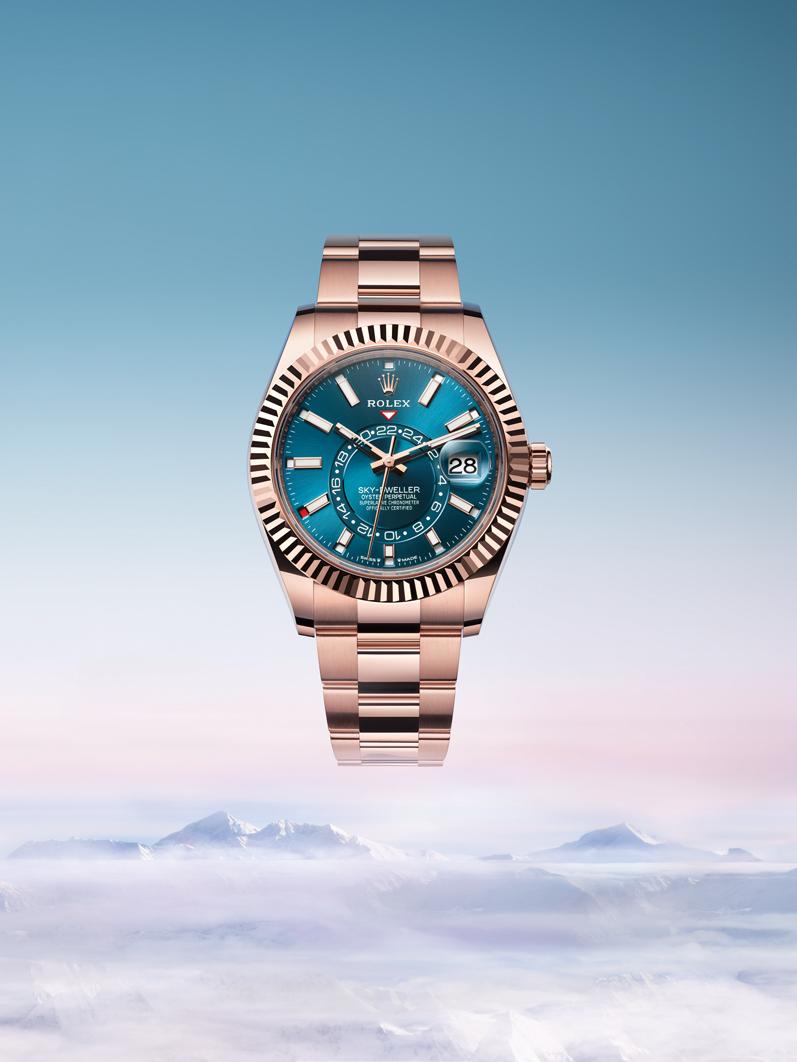
Sky-Dweller, the Rolex for “world travellers,” has been updated in 2023 with several aesthetic and technical enhancements. The collection gets three new variants featuring the Oyster case construction, in three case material and dial combinations – white gold with black dial, white Rolesor with green dial, and Everose gold with a brilliant blue-green dial. The trio also debut an updated movement.
Relatively speaking, the Sky-Dweller is one of Rolex’s younger collections, havering been introduced in 2012. However, Sky-Dwellers have rapidly climbed up the popularity charts among collectors, to become some of the most soughtafter watches to bear the Rolex crown. Developed with globetrotters in mind, the Sky-Dweller’s dual time zone and Saros annual calendar both stand out because of their unique and intuitive displays.
The first of the three new Sky-Dweller variants features an 18ct white gold case, which is making a return to the collection. It has a black dial and is fastened with a matching black Oysterflex bracelet. This is the first Sky-Dweller to combine the Oysterflex bracelet with a white gold case.
The Oysterflex, developed and patented by Rolex, is an innovative bracelet made up of two flexible, curved metal
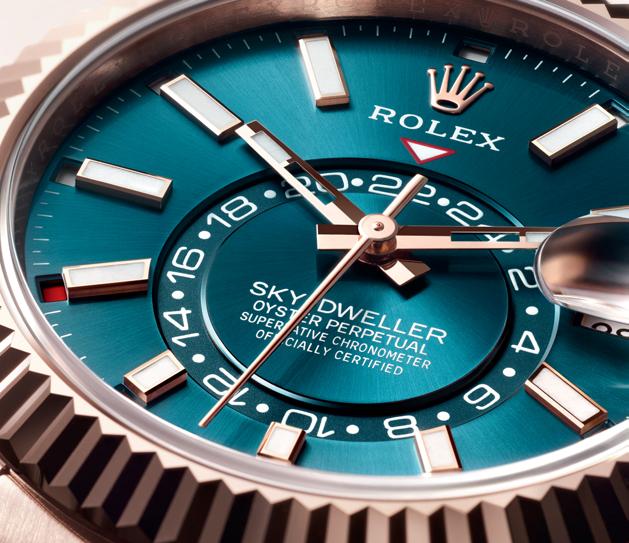
blades – one for each sections. These are over-moulded with the high-performance black elastomer synthetic material. It features the Glidelock extension system, which has a rack located under the clasp cover. This system enables fine adjustment of the bracelet length, without the need for tools. The Rolex Glidelock on the Oysterflex bracelet has six notches of approximately 2.5 mm, allowing the length of the bracelet to be adjusted easily up to some 15 mm.
The second Sky-Dweller variant, in white Rolesor, features a mint green dial, a colour reserved until now for the Datejust. The case is constructed using a combination of Oystersteel and white Rolesor - Rolex’s signature alloy that combines gold and Oystersteel. The fluted bidirectional bezel is in white gold. The winding crown, middle case, case back and the Oyster bracelet are in Oystersteel.
The 18ct Everose gold variant has a blue-green dial. A subtle fusion of two tones, this blue-green colour is available only on this reference. Rolex first introduced its patented Everose gold in 2005. This 18ct pink gold alloy, one of its signature materials, is used on all Rolex Oyster models in pink gold. This watch’s Oyster bracelet, middle case, bezel, crown and caseback are all in case-marching Everose gold.
The new Sky-Dweller white Rolesor and Everose gold variants are both fastened with an Oyster bracelet. This three-piece link bracelet, known for its robustness, remains the most universal in the Oyster Perpetual collection. The Oyster bracelet of the Sky-Dweller features the Easylink comfort extension link, which allows the wearer to easily increase the bracelet length by approximately 5 mm. On the Everose variant, the bracelet also includes patented ceramic inserts inside the links to enhance its flexibility on the wrist, as well as improve its longevity.
The distinct dial of the Sky-Dweller displays the time in two time zones simultaneously and has an annual calendar. While the local time is read using the conventional centre hands, the reference time is displayed in 24-hour format via an off-centre disc. A fixed inverted red triangle below the brand name points to the chosen reference time on the off-centre 24-hour disc.
The Saros annual calendar, which automatically differentiates between 30- and 31-day months, is operated by a patented mechanism. Only one date adjustment per year is needed, on 1 March, because February has only 28 or 29 days. The months of the year are shown in 12 apertures around the circumference of the dial, beyond the index hour marker. The current month is indicated by a red square.
The date change is linked to the local time. The SkyDweller also includes the Ring Command system - an interface between the rotatable bezel, winding crown and movement that allows the wearer to select and set the timepiece’s functions one by one, easily and quickly.
All three of the new Sky-Dweller variants have a 42 mm Oyster case, which means waterproofing to a depth of 100 metres. The middle case of all three versions is crafted from a solid block of metal - Oystersteel, white or Everose gold. The case back, edged with fine fluting, is hermetically screwed down with a special tool that allows only Rolex watchmakers to access the movement.
The Twinlock winding crown, fitted with a double waterproofing system, screws down securely against the case. The crystal, which features a Cyclops lens at 3 o’clock for easy reading of the date, is sapphire with antireflective coating.
All three new variants of the Sky-Dweller are powered by Rolex’s calibre 9002. Unveiled earlier this year, this selfwinding mechanical movement is a derivation of calibre 9001 - one of the most complex movements designed by Rolex. The 9001 has driven every Sky-Dweller model since its launch in
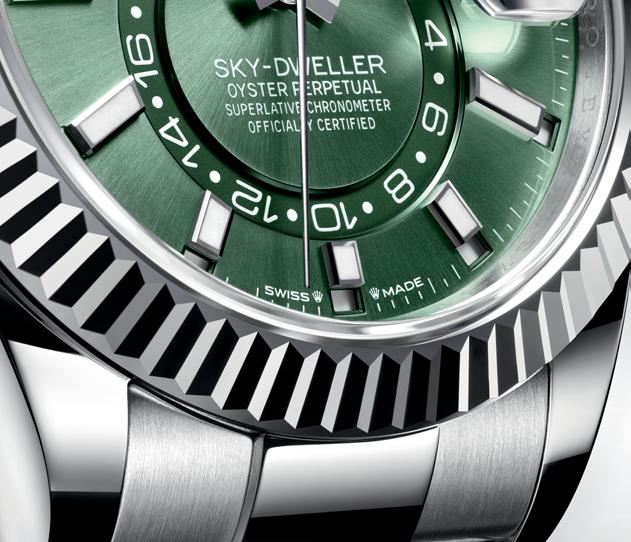


2012, delivering outstanding performance in terms of precision, power reserve, convenience and reliability.


Its successor, Calibre 9002, incorporates the patented Chronergy escapement, which combines high energy efficiency with great dependability. Made of nickelphosphorus, this escapement is resistant to strong magnetic fields. The movement is fitted with a blue Parachrom hairspring, manufactured by Rolex in a paramagnetic alloy.
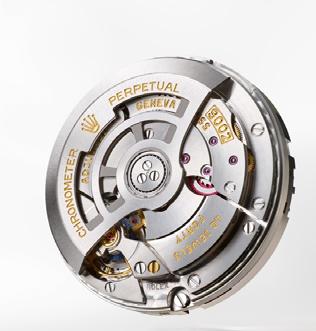
This hairspring offers extra stability in the face of temperature variations as well as high resistance to shocks. It is equipped with a Rolex overcoil, which improves the calibre’s regularity in any position. The oscillator is mounted on Rolex’s patented highperformance Paraflex shock absorbers, which increases the movement’s shock resistance. The oscillating weight is fitted with an optimized ball bearing.
Calibre 9002 is equipped with a self-winding system via a Perpetual rotor. Thanks to its barrel architecture and the escapement’s high efficiency, the power reserve of this calibre extends to approximately 72 hours.
Like all Rolex watches, the Oyster Perpetual SkyDweller is covered by the Superlative Chronometer certification, along with an international five-year guarantee. Symbolized by the green seal that comes with every Rolex, the Superlative Chronometer certification testifies that every watch leaving the brand’s workshops has successfully undergone a series of tests conducted by Rolex in its own laboratories according to its own criteria. This is done after the official COSC certification.
The in-house Superlative Chronometer certification test is applied to fully assembled watches, after casing the movement. This test measures a watch’s performance on the wrist in terms of precision, power reserve, waterproofness and self-winding.
Patek’s couplet of exceptional his-and-her watches featuring blue-dial and rose-gold
Patek Philippe unveiled an impressive line-up of 17 new models at this year’s Watches & Wonders, which included five Grand Complications, four Complications, four Calatravas, one Gondolo, and three Aquanauts. Our focus here is on two of these models – the masculine Calatrava 24-Hour Display Travel Time and the feminine Aquanaut Luce Annual Calendar.
While both possess impressive complications in their own right, and share a common heritage, it is their complementary aesthetics featuring deep-blue hues and rose-gold that make them an exceptional his-and-her pair.
Calatrava 24-Hour Display Travel Time (Ref. 5224R-001), as the name suggests, is the latest addition to Patek’s expanding portfolio of travel watches and complications designed for everyday use. The new Calatrava model is equipped with a dual time zone function and a 24-hour display. Its new calibre 31260 PS FUS 24H self-winding Aquanautmovement comes in an elegant rose-gold case with a navy-blue dial and strap.
Meanwhile, the Aquanaut Luce Annual Calendar (Ref. 5261R001) is the first model in the Aquanaut collection to feature the patented Annual Calendar. This non-gemset Luce model comes with a matching dial and strap adorned in blue-grey, and like the Calatrava, is encased in exceptionally well-finished and elegant rose gold.
Patek’s exclusive Travel Time system displays a second time zone with two central hour hands, one of which can be adjusted backwards or forwards in one-hour steps. This complication is popular with clients thanks to its ease of operation and excellent legibility.
Patek has previously paired the Travel Time system to great effect with a variety of styles and dial designs, from the Grand Complication Alarm Travel Time model (5520P-001) to the ladies’ Aquanaut Luce Travel Time (5269/200R-001), among several others. The Travel Time complication is also found in two of the new Calatrava Pilot chronographs (5924G-001 and 5924G-010) unveiled at W&W23.
However, the new Calatrava Travel Time model debuts a new design to display the local and home time via two centre
hands turning on a 24-hour circle. The manufacture has already used 24-hour displays in the past, notably on the Chronometro Gondolo watches produced in the early twentieth century. However, for the new Calatrava model, the designers have chosen to place noon at 12 o’clock, rather than at 6 o’clock, as in previous models, to improve legibility.
To power this watch, Patek’s engineers took the 31-260 ultrathin self-winding base calibre and added a 24-hour mechanism and a Travel Time mechanism. This movement, launched in 2011 in the Annual Calendar Regulator (Ref. 5235) was entirely reworked in 2021 for the In-Line Perpetual Calendar (Ref. 5236P-001). It had an operating frequency of 4 Hz, a 20 per cent increase in barrel-spring torque, a mini-rotor in platinum to boos the winding power, and a reduction wheel that uncouples the self-winding mechanism.
In 2022, Patek Philippe reworked this movement again for the Annual Calendar Travel Time (Ref. 5326G-001) and developed several innovations, leading to eight patent applications. The latest iteration of this calibre - 31-260 PS FUS 24H – powering the new Calatrava Travel Time benefits from three of those patents.
Visible through a transparent sapphire-crystal back, the new self-winding calibre is compact enough to fit inside a 42 mm case with a height of 9.85 mm. The total height of the watch is 11.76 mm. To preserve its sleek lines, Patek also replaced the traditional correction pushers for local time on the left-hand flank of the case. It has a patented correction system, which is activated by pulling the crown out to the intermediate position.
The fully polished rose-gold case draws inspiration from the Calatrava Weekly Calendar (Ref. 5212A-001) launched in 2019, distinguished by its curved two-tier lugs. The navy-blue dial shines with its elegance and legibility. It is enhanced by a double railway-track scale for the hours and minutes. The 24-hour display - with its alternating Arabic numerals and hour markers, and its cabochon five-minute markers – comprises a total of 44 rose-gold appliques. All are polished together to obtain the same brilliance, and are applied individually by hand.

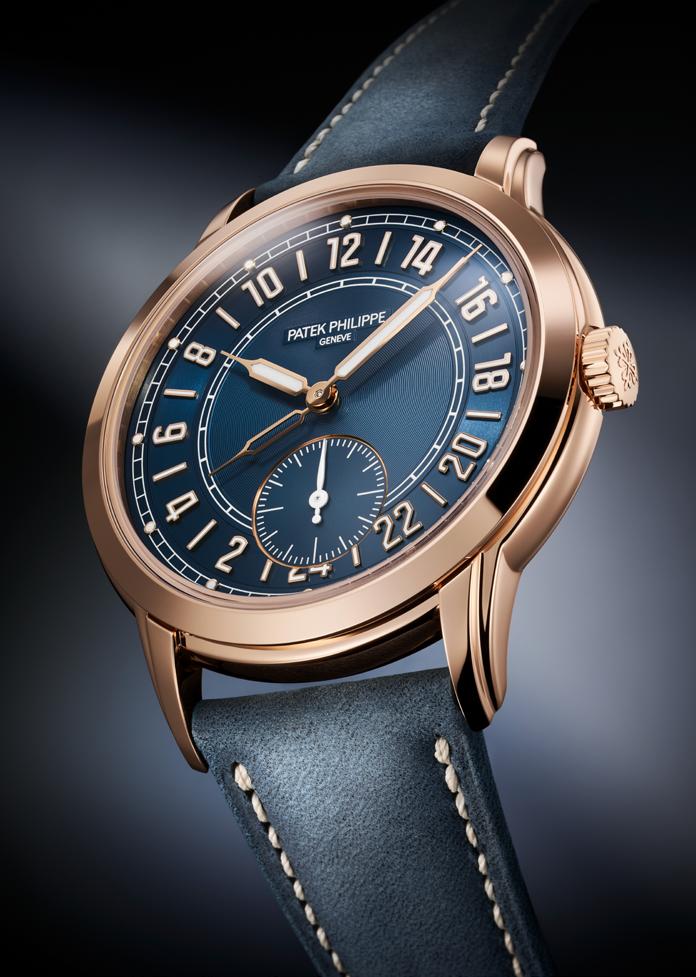
The Travel Time dual time zone is displayed by three syringe-shaped hands in rose gold. The local hour hand, the minute hand and the markers have a luminescent coating for a beautiful glow in the dark. Refined finishing touches create beautiful plays of light on the dial. A circular striated centre, a circular satin-finished hour circle and a snailed small-seconds counter with a rose-gilt outline all play their part in enhancing the watch’s appeal. A navy-blue calfskin strap - with a nubuck finish and contrasting cream stitching - echoes the colour of the dial. It is secured by a prong buckle in rose gold.
The Calatrava 24-Hour Display Travel Time’s companion from this year’s W&W debutants, the Aquanaut Luce Annual Calendar, features one of Patek’s patented mechanisms – a complete day/date/month calendar requiring only one manual correction per year, at the end of February.
Aquanaut Luce is a sub-collection within Aquanaut, launched in 2004, to appeal to the feminine casual-chic segment. It comprises a broad range of models, from stainless steel quartz models to Haute Joaillerie versions featuring the most sophisticated gem setting. Over the years, Patek Philippe has also endowed the Aquanaut Luce models with various complications, such as the Travel Time dual time zone or the self-winding chronograph. The new Aquanaut Luce Annual Calendar is the latest addition to this lineup.
Its 39.9 mm-diameter case houses the new self-winding 26-330 S QA LU calibre, with a central rotor in 21K gold and the additional Annual Calendar module with moon phases. A special feature of this watch is the inversion of the Annual Calendar module.
The calendar indications offer an unusual display compared to other Patek timepieces equipped with this complication. The date is displayed in an aperture at 6 o’clock, the moon phases in an aperture at 12 o’clock, and the day and month in subdials at 3 o’clock and 9 o’clock. The extremely precise moon phase indication deviates only one day in 122 years from the true lunar cycle.
The architecture of the movement is based on the calibre 26-330, introduced in the Calatrava Weekly Calendar (Ref. 5212A-001) – the same watch mentioned above as the inspiration for the new Calatrava 24-Hour Display Travel Time’s case design. The two timepieces, therefore, have a connection that goes beyond aesthetics.
The 26-330 calibre features several technical innovations. It has a patented anti-backlash wheel to prevent the seconds hand from vibrating. A patented clutch wheel improves the efficiency and longevity of the self-winding function. The presence of a “stop seconds” - which instantly stops the balance when the crown is pulled into the hand-setting position - allows adjustment to the nearest second. When the crown is pushed home, the mechanism gives a small impulse to the balance to set it in motion again.
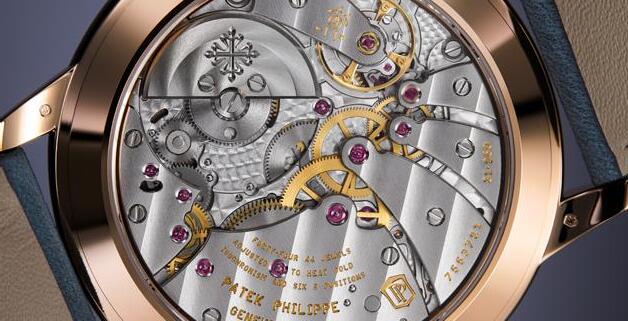
On the aesthetic front, the timepiece’s rose gold case and bezel, with their rounded octagonal shape, are enhanced by the contrast between polished and satin finishes. The model’s casual-chic style is reinforced by the elegant bluegrey colour adorning the dial and strap. This refined hue has proven its appeal on the steel Aquanaut Luce 5067A025, launched in 2018.
The dial, with the embossed Aquanaut pattern, features rose gold applied Arabic numerals and baton-style hands, all with white luminescent coating. The integrated composite strap with the Aquanaut pattern, echoing that of the dial, stands out for its comfort and high resistance to traction, wear, salt water and ultraviolet rays. It is fitted with a patented fold-over clasp.
Patek Philippe’s Calatrava 24-Hour Display Travel Time and Aquanaut Luce Annual Calendar, both debutants at this year’s W&W, both possess impressive complications, and both share lineage with the Calatrava Weekly Calendar of 2019. And, both are resplendent in their complementary combinations of deep-blue and rose-gold finishing, making them one of the standout his-and-her couplets of the season.
The Chopard and 1000 Miglia love affair
Continues with event sponsorships and new watches
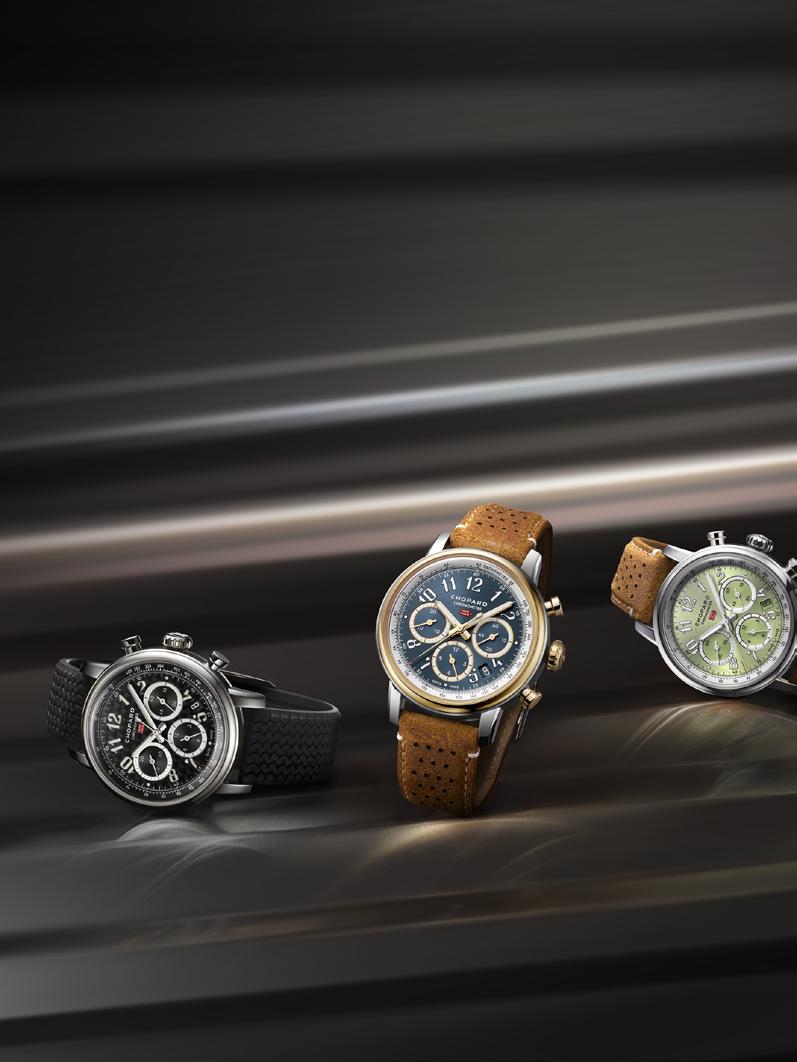 Mille Miglia Classic Chronograph
Mille Miglia Classic Chronograph
For the 36th year in succession, Chopard became the World Sponsor and Official Timekeeper of this year’s 1000 Miglia – “the most beautiful race in the world” - which took place between June 13 and 17. Also, in keeping with tradition, the maison has unveiled four new Mille Miglia Classic Chronographs, plus an ‘Italian Limited Edition’ of the Mille Miglia GTS Chronograph. Some of the proceeds from the sale of these watches will be donated to victims of the recent Emilia-Romagna flood disaster.

The Chopard and 1000 Miglia partnership represents one of the longest in history between a watchmaker and an automotive event. This partnership is driven by Chopard co-president Karl-Friedrich Scheufele’s passion for classic cars and motorsports. A passion confirmed by the fact that 2023 marks the 35th occasion that he has competed in the race.
Karl-Friedrich’s first participation was in 1989, with six-times Le Mans 24 Hours winner Jacky Ickx in the navigator’s seat. The pair teamed up again this year, as they have done on more than a dozen previous occasions in the intervening years. This year the duo tackled the route in a ‘metallic raspberry’ Mercedes-Benz 300SL Gullwing, the vary car in which they made their 1000 Miglia debut in 1989.
The 1000 Miglia, first run in 1927, set off this year from Brescia on June 13, on a course that took the participants on a clockwise circuit. It featured a new route, and held over five days instead of the usual four. Also, for the first time, the race incorporated a section from Parma to Milan, marking the first time that the Lombardy capital has been included in the 1000 Miglia.
Day one of the event ended with an overnight stop on the coast at Cervio-Milano Marittima. An early start on Wednesday took the group to the tiny, hilltop republic of San Marino - the fifth smallest country in the world. They then climbed up to 300 metres above sea level for a lunch break in Macerata - a town renowned for its striking palazzos, and annual opera festival. The day finished in Rome, where the cars paraded around the eternal city, followed by a dawn start on Thursday for the six-hour run to lunch in Siena, at the scene of the historic Palio horse race.
After tackling the famous Abertone Pass – frequently used by Ferrari’s test drivers – the cars arrived in Parma, where they spent the night before heading out on Friday morning to begin the ‘home run.’ The cars stopped at Piacenza military airport to mark the centenary of the Aeronautica Militare Italiana.


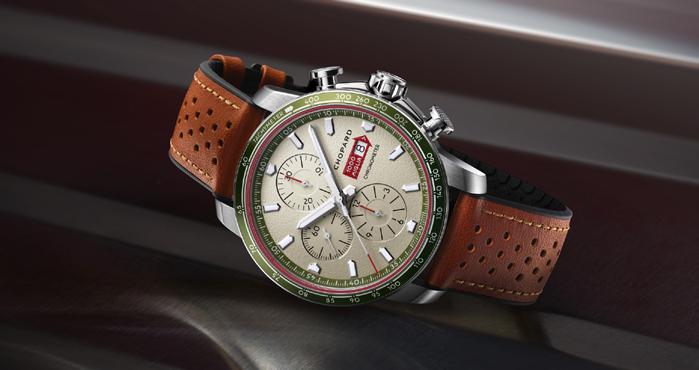

After lunch in Alessandria and a further five hours on the road, the competitors checked in at the new Milan time control point, followed by dinner and a well-earned night’s rest. A civilised 8am start on Saturday marked the beginning of the final 100 kilometres of the course, which took the surviving cars back to the finish at Brescia, where they paraded along the tree-lined Viale Venezia.
Chopard had two cars competing under the ‘Team Chopard’ banner this year. In addition to the Mercedes 300SL Gullwing, there was also a 1955 Porsche 356 Speedster driven by Chopard Ambassadors – the Chinese actor Zhu Yilong and Romain Dumas, the celebrated endurance racing driver.
Before setting off from Brescia for the 1000 Miglia, KarlFriedrich Scheufele hosted a special welcome dinner at the beautiful and historic L’Albereta hotel, just 20km from Brescia, and close to the breathtakingly beautiful shores of Lake Iseo. Here, the new Mille Miglia Classic Chronograph collection and the new Mille Miglia GTS Chronograph, both of which commemorate this year’s race, were presented to the guests. Thus, maintaining Chopard’s tradition of creating all-new dedicated watches for the 1000 Miglia, for each year since 1988.
This year’s Mille Miglia Classic Chronographs are distinguished by their dial colours. Each of the four variations is based on the paint hues and interior finishes typically found on the type of pre-1957 cars that are eligible for the 1000 Miglia. That means a choice of Rosso Amarena (cherry red),
Grigio-Blu (grey blue), Verde Chiaro (light green) and Nero Corsa (racing black). In keeping with a 36-year tradition, each watch carries a miniature ‘1000 Miglia’ route marker on its dial and case back.
The four new models are crafted in Chopard’s exclusive Lucent Steel. This alloy is 50 per cent more resilient than regular steel and incorporates material recycled from the medical, aerospace, car and watch industries. The 40mm chronographs are fitted with either the maison’s signature rubber strap featuring the pattern of a ‘60s Dunlop race tyre, or a rich brown calfskin leather strap evoking traditional driving gloves.


The slightly larger Mille Miglia GTS Chrono, at 44mm, is also made from Lucent Steel. Limited to just 100 examples, part of the proceeds from the sale of this watch will be donated to victims of the devastating floods that swept through the EmiliaRomagna region in early May.
This edition carries the green and red colours of Italy, with its olive green bezel featuring a tachymeter scale for speed and distance calculations. The GTS Chrono is also fitted with substantial ‘mushroom’ pushers and a large diameter crown to provide a firm grip and ease of use while on the road.
Both the Chopard Mille Miglia Classic Chronographs and the Mille Miglia GTS Chrono are not limited to just those taking part in ‘the most beautiful race in the world,’ but are available for all those who appreciate and admire it.
It is a very rare event in the watch-collectors universe, where rarity is the norm, that a timepiece by Philippe Dufour is offered for sale. Dufour produces so few watches, and of such exceptional quality, that to discerning collectors, the possibility of acquiring a Philippe Dufour is nothing short of a long-held dream-come-true moment.
This autumn, Christie’s Geneva will present one of these very rare moments, when a one-of-a-kind Philippe Dufour Simplicity watch will be offered by a private collector.
Philippe Dufour is regarded among the greats of modern watchmaking, some even qualifying him as the greatest master watchmaker of our times. A Philippe Dufour watch has clean, classic lines, and is powered by exceptional in-house movements. Every component of the watch, irrespective of whether it is visible or not, is beautifully hand-finished to the highest standards.
A Dufour watch is designed and constructed to stand the test of time. In fact, Dufour insists that his watch should be easily repairable even a century after its made. Every watch is customisable as per the client’s wishes, making each one unique. These qualities combine to make a Philippe Dufour watch highly sought after by watch enthusiasts, and for which they are willing to wait for years.
Dufour usually works alone in his spacious atelier, a former schoolhouse in le Solliat, a village in the Vallée de Joux - the epicentre of Swiss watchmaking. The atelier doubles as a working museum to Dufour’s lifelong work. One can find his drawings, archives, customized watchmaking tools, prototypes,the watches he is working on, and his collection of pipes. These days, he has the company of his youngest daughter Danièla Dufour, an accomplished watchmaker, who intends to carry on her father’s legacy.
Philippe Dufour was born in 1948, in a small Vallée de Joux village. After he had completed middle school, at the age of 15, Dufour decided to become a watchmaker instead of perusing higher education. After he had finishing his training at Ecole d’Horlogerie de la Vallée de Joux, he was hired by JaegerLeCoultre in 1967. Like many other greats in the field, he began his career by restoring antique watches. While working on these historical timepieces, he learnt how the old masters of horology made their intricate complications using relatively unsophisticated tools.
As the years passed, Dufour earned a reputation as a watchmaker of renown, and had worked at several leading Swiss watch manufacturers, including Gerald Genta. In 1982, Audemars Piguet approached Dufour and asked him to produce five Sonnerie movements for pocket watches. He started work on the complications in 1982, and delivered the last of the five in 1988.
Once the Audemars Piguet watches had been delivered, Dufour felt confident enough to set up an independent atelier. Thus, becoming one of the first independent Swiss watchmakers. He presented the first wristwatch to bear his name at Basel World in 1992.
The ‘Philippe Dufour Sonnerie’ became the world’s first minute-repeater grande sonnerie wristwatch. This was an unprecedented feat for an independent watchmaker in those days because chimers are considered, even today, as being among the most challenging complications to put in a wristwatch.
Dufour presented his second model, Duality, in 1996. It became the world’s first wristwatch with a double escapement. For this watch, he had to perfect the functioning of two independent balance wheels such that their differential would
We look back at the life of Philippe Dufour, the master watchmaker, to find out why his watches are so sought after


average out their errors, thus significantly improving accuracy. Only nine examples of Duality were ever produced for clients. While most watchmakers veer towards greater complexity with the passage of time, Dufour went in the opposite direction. He became enamoured with concepts such as purity and simplicity. Thus, at Baselworld 2000, Dufour presented his third watch called Simplicity. This minimalist masterpiece is considered one of the finest examples of time-only watches ever produced.
According to Claude Sfeir, an eminent watch collector and Dufour’s business partner, Simplicity began as a personal design study inspired by the elegant styles of the 1950s and ‘60s. As the name suggests, this is a simple time-only watch with central hour and minutes hands, and a seconds subdial at 6 o’clock. However, it is produced using traditional watchmaking tools and has near-perfect hand craftsmanship. The pièce de résistance of this watch, as always, is the movement featuring decoration the likes of which modern horology had not yet witnessed when the watch was unveiled. Dufour had planned to produce around 200 Simplicity watches when he presented it at Baselworld, but the demand was such that the entire allocation sold out expeditiously. It took Dufour just over two decades to deliver the 200 pieces, in either gold or platinum, and often customized to the client’s wishes. No wonder that the few who possess a Simplicity timepiece are reluctant to part with them.
One example of Dufour’s Simplicity watch is exhibited at The Espace Horloger watch museum in Switzerland. Dufour has also gifted a one-of-a-kind steel Simplicity with eastern Arabic markers and a golden “vintage” dial to Claude Sfeir’s son Simon.
In 2020, to commemorate the 20th anniversary of Simplicity, as well as the completion of the 200-pieces, Dufour
announced a 20-pieces special edition Simplicity – seven in pink gold, seven in white gold and seven in platinum. Dufour will be keeping the 21st piece for himself. This anniversary Simplicity has a 37mm diameter case but with a hinged caseback. The crown has the “PD” emblem engraved on it. The dial is guilloché grey with Breguet numerals instead of markers, and the “PD” emblem replaces the 12 o’clock marker.
Like its predecessor, the demand for the anniversary Simplicity was so overwhelming that Dufour and Sfeir decided to allocate ten pieces to known collectors, and allocate the remaining ten based on a draw. One of these anniversary Simplicity watches - with movement Number 00/20 - came up for auction in 2020. It had an estimate of CHF 200,000 - 400,000 (US$ 218,000-436,000), but fetched CHF 1.36 million (US$ 1.5 million).
The Simplicity being offered by Christie’s Geneva this autumn is one of the original 200. Its certificate is dated June 3rd, 2021, which happened to be Dufour’s 73rd birthday.
This will be the very first Philippe Dufour wristwatch with a steel case to be offered publicly. Its size, at 38mm, sets it apart from the other models, which have either 34 or 37mm cases. The movement has an inimitable rendering of Côtes de Genève. The detail that makes this timepiece stand out visually is on the stunning royal blue dial. As per the client’s wishes, this watch does not have a small second sub-dial. Also, it has singular hour markers.
This is probably why Dufour is reported to have said - “this is true simplicity” - when handing over the watch to his client. The combination of all these elements makes this watch truly exceptional, even by Philippe Dufour’s standards. It is, therefore, warranted to say that the minimalist blue Simplicity will most likely exceed all estimates when the hammer comes down in Geneva.


Bentley has announced a global calendar of ‘Extraordinary Journeys’ - a travel series for Bentley owners designed to deliver “once in a lifetime road trip” experiences. It will offer exclusive access to “the very best of local cuisine, design, architecture, and wellness combined with unforgettable driving experiences in a variety of stunning landscapes.”
This small-scale Bentley speciality travel series will initially cover the UK, New Mexico and Scandinavia and with more locations to be announced throughout 2023, including a Middle Eastern Extraordinary Journey through Oman. These journeys range from three to five days of scenic driving, with overnight stays in unique, luxury accommodations. Sustainable, seasonal, and locally sourced produce will be served to guests throughout the programmes.

Each journey is designed to be an immersive experience in the culture of the area and feature local experiences. For example, the Scandinavian Extraordinary journey will take in the very best of Copenhagen as Denmark celebrates its Year of Architecture. It will involve various private dining and wellness experiences, exclusive access to the BIG architecture and design studio, as well as a take-over of one of the finest design hotels.



The journey then proceeds on smaller rural roads, surrounded by the countryside. Guests will be served lunch on the edge of Lake Vättern in southern Sweden. This will be followed by a night at a 5-star Forest Hotel, nestled in the Swedish woodlands. The hotel offers luxurious treehouse suites that combine a full wellness experience with forest dining from a chef who specialises in sustainable Nordic cuisine.
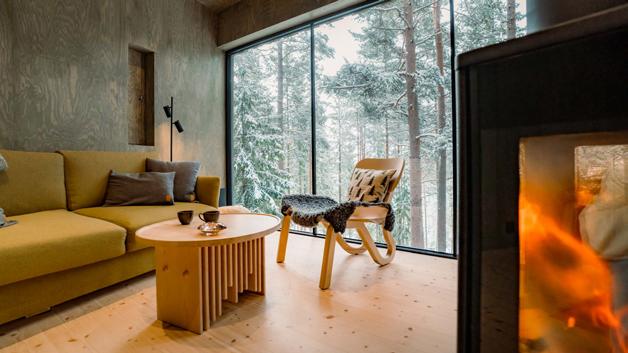
Caren Jochner, Global Head of Brand Experience at Bentley Motors, said, “We want to share with our customers and fans an extraordinary journey of discovery offering access to usually private and exclusive experiences that only Bentley can provide.
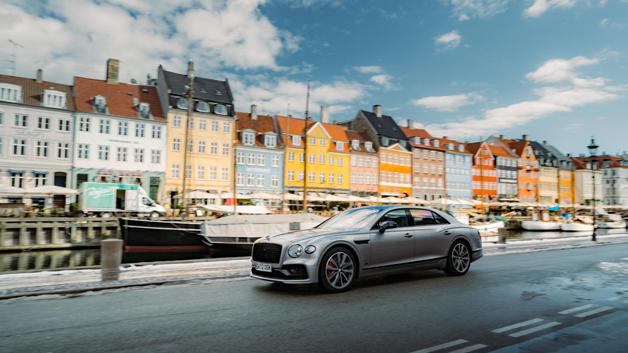
“We have worked closely with globally like-minded partners that share our passion for excellence whether it be in the field of cuisine, design, architecture, or wellness – all with sustainability at heart. This, coupled with our carefully curated driving experiences provides something truly unique – an Extraordinary Journey and once in a lifetime experience that offers the opportunity to connect you with like-minded souls –an experience money alone can’t buy.”
The Extraordinary Journey Oman, yet to be announced formally, promises to bring together “the best driving and destinations Oman has to offer” as part of an adventure spread over four-days and three-nights.

With the new Blue Shadow collection, Rolls-Royce aims to recreate the essence of the Kármán Line

“We venture to the fabled Kármán Line, where the constraints of Earth give way to the infinite freedom of outer space: a zone of incomparable beauty, mystery and boundless possibility.” This is how Torsten Müller-Ötvös, CEO of RollsRoyce described the inspiration behind the marque’s new Black Badge Cullinan ‘Blue Shadow’ Private Collection.
The Kármán Line is the invisible boundary 100 kilometres (62 miles) above the Earth’s surface where our atmosphere ends and outer space begins. It is in this mystical region, that the blue of the sky we see on Earth ends, and the blackness of space begins. In between the two, is an intense dark-blue zone where darkness becomes visible.
Only a select few have been fortunate enough to witness the sublime beauty of the Kármán Line. With the new Blue Shadow collection, Rolls-Royce aims to recreate the essence of this ethereal boundary. Limited to just 62 examples worldwide, the collection is available exclusively through Rolls-Royce Private Office.
The shimmering new ‘Stardust Blue’ paint of the Blue Shadow Collection’s exterior captures the deep blue colour of the upper layers of the Earth’s atmosphere. The satin-tinted grille surround and aero bumper insert sets recall the thermal tiles used to shield Space Shuttles from the intense heat during atmospheric re-entry.
Drawing further from the materials used in spacecrafts, the Spirit of Ecstasy is created using 3D printing techniques in titanium. It is then finished with a thin layer of bluetinted lacquer which adds pearlescence while revealing the titanium’s grained texture. The Black Badge infinity logo and ‘Blue Shadow’ Private Collection name are engraved on the Spirit of Ecstasy base and infilled with Charles Blue. Completing the exterior aesthetic, Blue Shadow’s wheels are subtly darkened using a translucent lacquer.

At the Kármán line, the visible edge of Earth’s atmosphere appears as an ethereal blue halo. This transition from blue sky to the inky darkness of space is captured on Blue Shadow’s unique painted fascia and door panels. These were created using six layers of paint, combining five different shades of blue with a deep black hue to produce a mesmerizing three-dimensional effect.
The final touch is a clear-coat layer incorporating blue and clear glass particles to add further depth and lustre. According to the marque, “the ratio was precisely identified down to a fraction of a per cent: it is exactly 0.05%.” The fascia is completed with a Bespoke clock, produced specially for the Private Collection. The clock features light blue anodized details and a ‘Blue Shadow’ engraving.
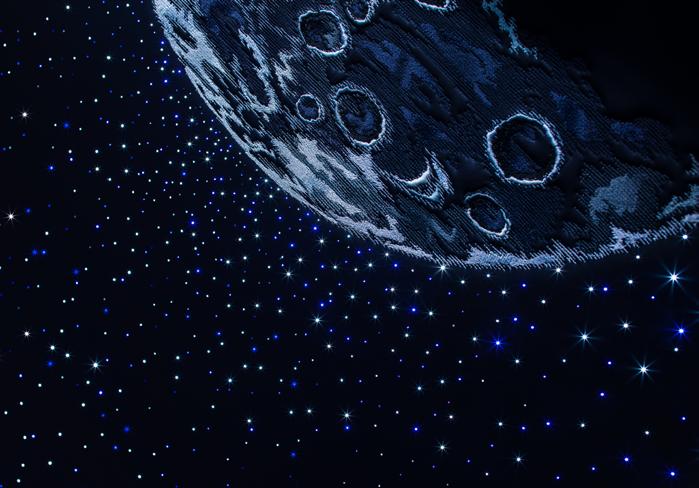


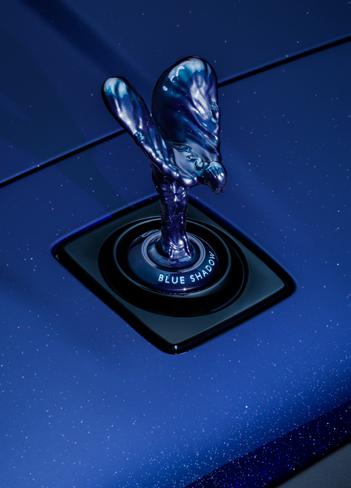

In the Blue Shadow collection, Rolls-Royce has taken the marque’s signature Starlight Headliner to new heights. The centrepiece is an intricate Moon embroidery, surrounded by an array of stars. The Moon’s surface, with its multitude of craters, was recreated in three-dimension with embroidery that incorporates five different colours of thread. Each thread is applied with a different technique to produce a distinctive texture. In total, the embroidery is created from 250,000 separate stitches, a process that takes two days to complete.

Filling the cabin with a gentle glow and a sense of wonder, the Starlight Headliner contains a total of 1,183 stars – 799 white and 384 blue. Each one of these has been individually placed in the leather canvas through perforated holes, precisely chalked and punched by hand. To add to the Headliner’s mystique and ambience, the twinkling effect of the fibre-optic ‘stars’ is further enhanced for an even more enchanting glow.
In a first for Rolls-Royce, the front and rear seats feature a unique perforated artwork, inspired by the view of Earth from space. Formed from a multitude of tiny perforations in the leather, the pattern conjures up the impression of organic, ever-shifting clouds swirling over the continents and oceans.
These perforations are made in two different sizes. The smaller ones, at just 0.8 mm in diameter, form the land, while the slightly larger 1.2 mm perforations define the sea. The blank spaces of leather in between represent the clouds. Each seat has over 75,000 perforations, all individually placed.
This pattern took two weeks to design and underwent five trials before it attained the level of quality acceptable
to the Rolls-Royce Bespoke Collective. The result is a perfect alignment of the design, ensuring a cohesive, uniform appearance across all four seats.
The seats’ perforation pattern is extended to the picnic table backs. Once lowered, the picnic tables themselves are finished in Piano Black veneer and incorporate a glass sparkle finish, evoking the view into the darkness of space. Each table also includes the Collection theme text, inlaid in polished aluminium beneath the top lacquer layer.
The Rolls-Royce Bespoke Collective has created a series of exclusive accessories to complement the 68 Blue Shadow cars. For example, the exclusive indoor car cover echoes the pattern seen on the seats, and a unique luggage set features the Private Collection’s colourway.
Clients can also commission an exact 1:8 scale replica of their full-size Black Badge Cullinan Blue Shadow. It features fully functioning exterior and interior lights, doors that open and close, and an interior that recreates the collection’s detailing, down the bespoke treadplates.
“In creating Blue Shadow, the Bespoke Collective of designers, engineers and craftspeople captured this spirit by embarking on their own voyage of discovery, once again pushing the boundaries of craftsmanship. Blue Shadow is a testament to our relentless pursuit of perfection and a celebration of the spirit of exploration, designed for the unique individuals who expand horizons and represent the very best of human endeavour,” says Müller-Ötvös.
Mercedes-Maybach’s new Night Series aesthetic package will be available on all Maybach series models

Mercedes-Maybach’s new Night Series package, suitable for all Mercedes-Maybach series models, offers a new dark look with extravagant exterior and interior elements. Details include dark chrome elements, surfaces that catch the light like a cut jewel and interiors that take the Maybach design language to new levels of exclusivity.
“The Mercedes-Maybach brand goes beyond the product, which is why it is so important to create experiences and options that fit our customers’ status and personal style. Night Series is the next step in offering a true luxury, tailored experience targeted at a new audience, but simultaneously responding to current customers’ desires,” said Daniel Lescow, Head of Mercedes-Maybach.
The Night Series was unveiled at a private residence in Greenwich Village, New York. The exclusive pop-up cocktail evening, recreating the Maybach clubhouse vibe, was a suitably sumptuous and discreet experience for attendees.
The Night Series package was exhibited on three Maybach models: EQS SUV, the S-Class and GLS.

The Night Series package designed for the three demonstration models all included elements in dark chrome, rose gold details and wheel design featuring darkglossy Maybach patterns, as well as interior herringbone decor. Under its “Black labels and backlights” motto, a new and exclusive start-up animation for the user interface compliments the Night Series colour palette. In addition, each model also features its own unique design signatures.
The Night Series version of the EQS SUV – the first electric Mercedes-Maybach and the brand’s newest modelfeatures headlights adorned with a Maybach emblem on rose gold and with dark chrome refinements. The grille panel is enhanced with darkened Maybach pinstripes, while the air intake inserts in the front bumper are refined with a dark chrome-plated pattern of the Maybach emblem.


Mercedes-Maybach’s new Night Series package, suitable for all Mercedes-Maybach series models, offers a new dark look with extravagant exterior and interior elements. Details include dark chrome elements, surfaces that catch the light like a cut jewel and interiors that take the Maybach design language to new levels of exclusivity.
“The Mercedes-Maybach brand goes beyond the product, which is why it is so important to create experiences and options that fit our customers’ status and personal style. Night Series is the next step in offering a true luxury, tailored experience targeted at a new audience, but simultaneously responding to current customers’ desires,” said Daniel Lescow, Head of Mercedes-Maybach.
The Night Series was unveiled at a private residence in Greenwich Village, New York. The exclusive pop-up cocktail evening, recreating the Maybach clubhouse vibe, was a suitably sumptuous and discreet experience for attendees. The Night Series package was exhibited on three Maybach models: EQS SUV, the S-Class and GLS.
The Night Series package designed for the three demonstration models all included elements in dark chrome, rose gold details and wheel design featuring darkglossy Maybach patterns, as well as interior herringbone decor. Under its “Black labels and backlights” motto, a new and exclusive start-up animation for the user interface compliments the Night Series colour palette. In addition, each model also features its own unique design signatures.
The Night Series version of the EQS SUV – the first electric Mercedes-Maybach and the brand’s newest modelfeatures headlights adorned with a Maybach emblem on rose
gold and with dark chrome refinements. The grille panel is enhanced with darkened Maybach pinstripes, while the air intake inserts in the front bumper are refined with a dark chrome-plated pattern of the Maybach emblem.
The EQS SUV is brimming with unique accents and details, including side windows with generous, highly polished, black edging in 3D design. A rear and roof spoiler complement its sporty-aerodynamic trim. The running board is refined in black, sporting a Maybach emblem in dark chrome. The signature paint finishes include Obsidian Black, Manufaktur Diamond White Bright and an exclusive two-tone paint finish in Obsidian Black and Mojave Silver combination.
The EQS SUV’s interior is carpeted with Econyl. The leather used is vegetable tanned in Crystal White or Black and Black Pearl colour combination with contrast topstitching in Dark Basalt Grey. The trim comprises openpored herringbone with genuine aluminium pilasters.
The Mercedes-Maybach S-Class Night Series version includes various paint finishes in grey, black and white hues, as well as an exclusive two-tone paint finish in Onyx Black and Mojave Silver combination. Other details include rose gold in the headlights and dark metallic chrome elements, adding to the design’s elegant, stretched silhouette. This aesthetic is further accentuated by the two visible tailpipe trims in dark chrome and black.
The interior expands the exclusivity of the Maybach S-Class with two interior variants: Black with Black Pearl nappa leather or Manufaktur Deep White and Black. A noble mother-of-pearl effect in the black-and-Black Pearl nappa leather option, together with the golden-grey glossy

Jaguar’s new Project ZP honours E-type’s first race wins with seven pairs of restored E-types

Jaguar is honouring the E-type’s first race wins with Project ZP. This exclusive collection comprises seven pairs of restored E-types, and each pair consists of an Oulton Blue drophead coupe and a Crystal Grey fixed-head coupe, along with matching period-specific helmets and other accessories.
The story of the present-day Project ZP dates back to the day after the E-type was launched to huge fanfare at the 1961 Geneva Motor Show. That day, Claude Baily, Jaguar’s Chief Designer at the time, detailed the specifications of what he called Project ZP to his engineers. The seven cars allotted to the project would each receive engine modifications and enhancements for components such as the cylinder block and cylinder head and the inclusion of a close ratio gearbox.

Just one month later, on 15th April 1961, the Project ZP cars made their racing debut. Two of them, ‘ECD400’ and ‘BUY1’ - referred to by their registration numbers - took first and third positions in the Oulton Park Trophy for GT cars. This marked the beginning of the E-type’s racing career, and a continuation of Jaguar’s racing pedigree established by the C-type and D-type.
The winning car at Oulton Park, ‘ECD400’ was an Indigo Blue E-type driven by Graham Hill, while ‘BUY 1’ was a Pearl Grey example driven by Roy Salvadori to third place. Salvadori then went on to win at Crystal Palace on 21st May 1961. In total, between 1961 and 1964, the E-types achieved 24 podium finishes.
Inspired by Graham Hill’s ‘ECD 400,’ the drophead coupe is finished in Oulton Blue. It features a black hood and a range
of exterior details that pay homage to the debut race-winning vehicle. The roundels on the bonnet and door are finished in white, with matching front ‘lipstick’ around the inside of the front air intake.
The motif bar across the grille and front overriders have been removed, in keeping with the original. However, unlike the original which was developed just for racing with no regard for finishes, Jaguar Classic engineers had to rework and handfinish the nose with over 40 additional hours of labour.
There are chrome bumpers front and rear. The wire wheels and wheel spinners bear Jaguar’s Heritage logo. To ensure a period-correct look for 1961, a beech wood steering wheel is joined by other early E-type characteristics, including welded bonnet louvres and external bonnet latches with a lockable key.
A selection of additional ZP details are visible on the fuel filler cap, exterior car cover and roof cover, while ZP and Jaguar logos appear on the rear. There is also a graphic on the wing of the car, with the Union Jack set within a silver shield containing the E-type’s silhouette and Project ZP wording. The external bonnet locks have ZP logos and are joined by a leather bonnet retention strap.
The interior features red leather by Bridge of Weir and inperiod Hardura trim. The suite of additional enhancements includes a golden growler horn push. The centre console, finished in anodised aluminium, features hand-engraved panels by master engraving artist Johnny “King Nerd” Dowell. These art panels are anodised in batches to modern highquality standards.



For the Oulton Blue drop-head, the design features engravings of the car’s silhouette, the Oulton Park track layout with a chequered flag and one-half of a laurel wreath. It also contains Hill’s famous quote: “In a race, my car becomes part of me, and I become part of it.”
While all of the original Project ZP cars were based on drophead coupes, the vehicle inspired by Roy Salvadori’s ‘BUY 1’ is reimagined as a fixed-head coupe. This was done to offer clients examples of both body designs. Inspired by the original car’s Pearl Grey paintwork, its new incarnation is finished in Crystal Grey. The colour takes its name taken from the track where Salvadori got his first win.
This fixed-head coupe comes with white roundels and similar exterior detailing as the drophead, with the removal of the motif bar and Jaguar badge across the grille. The coupe sports the same chrome bumpers as the drop-head, along with the welded bonnet louvres and side graphic detail. Created with specialists Vaughtons - based in Birmingham’s ‘Jewellery Quarter’ - the exterior badging mimics the appearance and design of inperiod racing stickers.
Inside, it features Dark Navy Bridge of Weir leather with matching Hardura trim and a Beechwood steering wheel. The centre console’s aluminium detailing is anodised in grey. Its design includes the other half of the laurel wreath engraved on the console of the Oulton Blue car. The track outline is of Crystal Palace and the text spells out Roy Salvadori’s nickname “King of the Airfields” alongside a silhouette of the vehicle.
Both cars feature a suite of additional enhancements from the team at Jaguar Classic Works. These include the Jaguar Classic Infotainment System with DAB radio, Bluetooth connectivity and navigation for 21st-century standards of incar entertainment.
On the technical side, the engines powering the ZP Collection cars are based on the specification of the 3.8-litre Series One E-types produced between 1961-1964. This engine features an authentic 1961-style alloy radiator with an electric cooling fan
and electronic ignition for everyday usability. It also comes with a polished stainless steel exhaust system.
The most significant mechanical upgrade is the specially developed five-speed manual transmission for quieter, more comfortable cruising. It features synchromesh on all ratios, helical cut gears and a reinforced cast aluminium casing for enhanced reliability and durability, with closer gear ratios for smoother changes.
Despite providing an extra ratio, the transmission’s intelligent design requires no modification to the bodyshell, or any of the other components. Maintaining the donor vehicle’s integrity is paramount to the team at Jaguar Classic, and the gearbox they developed allows the body’s originality to be retained, as well as giving customers increased usability.
Each vehicle comes with a period helmet to match those worn by Hill and Salvadori. These helmets are crafted by British expert Bill Vero of Everoak, who has been manufacturing helmets since the 1950s. The faithful reproductions are beautiful display pieces that can be worn, and are adjusted for each client.

They are provided with a tailored leather storage bag crafted from the same leather as the interiors and made onsite by the in-house trimmers at Jaguar Classic. Using the same leather, they also make the pouch for the car’s handbook. Supplied with each vehicle is a tailor-made car cover with ZP logo and a bespoke jack with an exclusive storage bag to be stored beneath the boot floor.
“The E-type ZP Collection is the ultimate tribute to the E-type’s triumphant racing debut, in itself part of Jaguar’s rich motorsport history,” says Paul Barritt, Director of Jaguar Classic. “Each pair tells a fascinating, and often untold, story of the E-type’s history. The ZP Collection honours not only the vehicles, but the racers who drove them to victory on the track. With 2,000 hours lovingly spent on each vehicle by the craftspeople at Jaguar Classic, our discerning clients will be able to enjoy a unique tribute to two of the greatest cars in the E-type’s history.”
Maserati’s first Fuoriserie Essentials collection, designed by its brand ambassador David Beckham
Maserati recently unveiled Fuoriserie Essentials, a collection of exclusive cars designed by “select tastemakers and friends of the Trident.” The first of these Fuoriserie Essentials has been designed by the marque’s global brand ambassador David Beckham.
“Fuoriserie means ‘custom-built’ in Italian, and our Trident’s customization program is conceived to create singular experiences for our clients,” says Klaus Busse, Head of Design of Maserati. “Our wish here is for them to express their personality and passion by creating their very own Maserati.

“Just like David, everyone can choose from a wide range of personalization features from our Fuoriserie Corse collection, inspired by Maserati’s glorious racing heritage, and from our Fuoriserie Futura collection, dedicated to lovers of technology and new materials.”
Fuoriserie Corse offers a selection of colours as materials inspired by the historical bodyworks of the Officine Alfieri Maserati, the original entity founded by Alfieri and Ettore Maserati. The exterior and interior design options are meant to evoke the classic racing vehicles from Maserati’s illustrious history, and include several legacy liveries - from clean stripes to striking patterns.
Fuoriserie Futura collection, as the name suggests, is all about looking ahead. The interior options feature some of the latest technologies available in the automotive industry, as well as sustainable materials. The style is clean and graceful. Its exterior



“Just like David, everyone can choose from a wide range of personalization features from our Fuoriserie Corse collection, inspired by Maserati’s glorious racing heritage, and from our Fuoriserie Futura collection, dedicated to lovers of technology and new materials.”
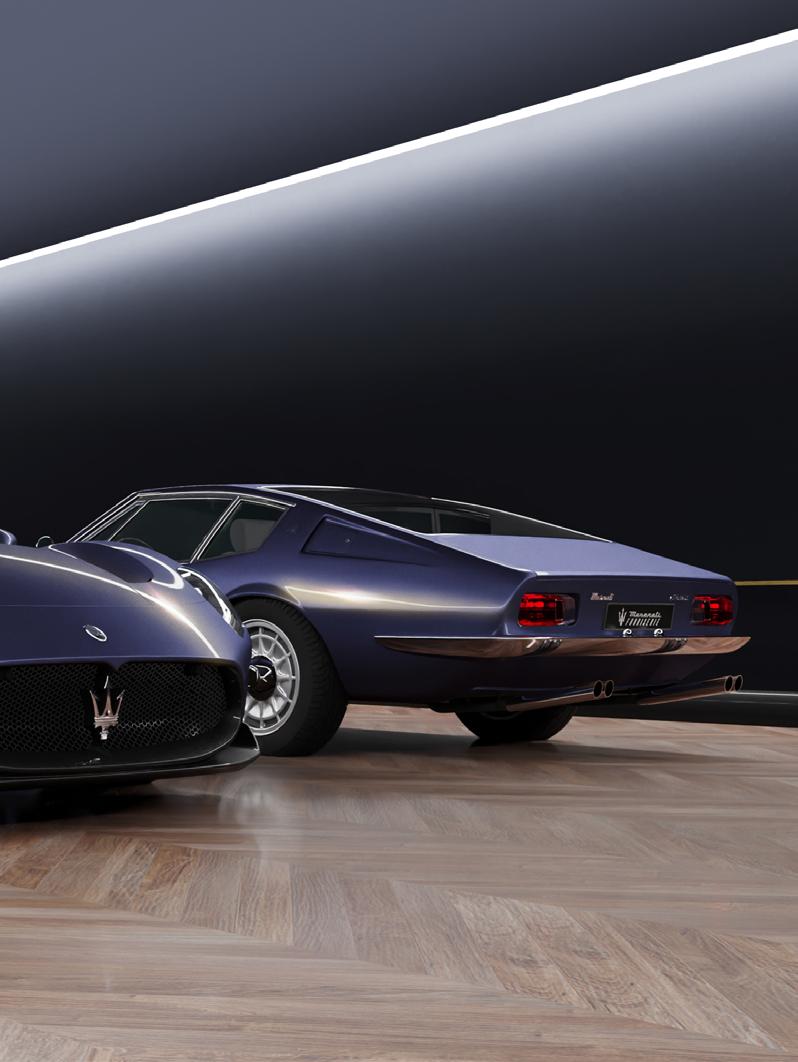
Klaus Busse, Head of Design, Maserati.

colour selection offers a mix of classic and innovative shades. The interior selection offers several industrial tones.
David Beckham has designed two distinctive car configurations for his ‘Fuoriserie DB Essentials’ collection. He drew inspiration from his fascination for Maserati classic cars, and conceived the collection as an extension of his Savile Row sartorial wardrobe.
Captivated by the 1967 classy Maserati Ghibli coupé, Beckham selected a ‘Night Interaction’ blue for the exteriors of his first DB Essentials, and matched it with a tan shade for the leather interiors. For his second configuration, Beckham paid
tribute to the 1986 Maserati Quattroporte Royale, only 51 units of which were produced. Here he chose ‘Verde Royale’ (dark green) hue for the exterior paint, with warm brown leather upholstery inside.
An exclusive metal plate celebrating the collaboration between Maserati and David Beckham is applied to the central tunnel between the front seats or between the two headrests. Both Fuoriserie DB Essentials configurations are now available upon request on the MC20 super sports car, and the new Grecale SUV.
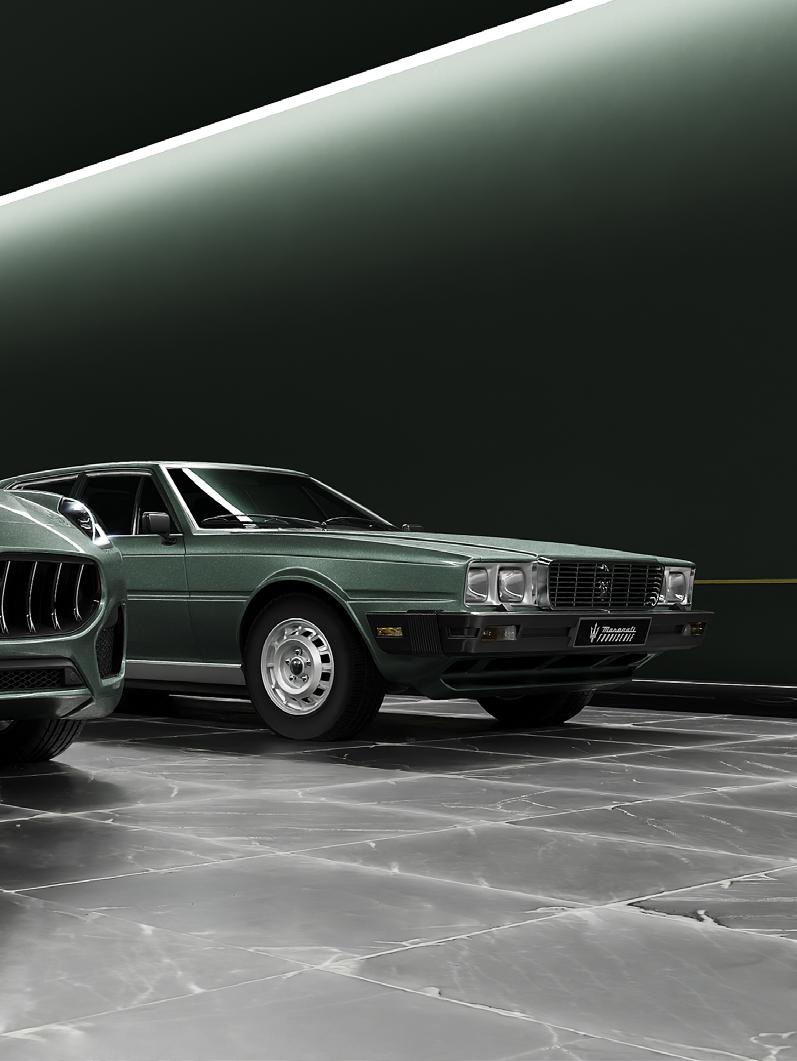
Loro Piana’s Resort Collection echoes the Italian spirit of vacationing. This spirit is expressed through a distinct evocative taste that combines with an easy-going style. The result is relaxed silhouettes that glide over the body, letting the wearer savour the freedom of summer.
The maison’s renowned savoir-faire transforms precious yarns into premium fabrics that combine silk, cotton and linen, featuring different textures, from the lightest to tweed. The palette ranges from the colours of dawn to sunset, from dynamic striped and floral prints to subtly shaded ones. The silhouette offers versatile clothes that express elegance with comfortable all-day wearability.
Linen, in crêpe or in Loro Piana’s exclusive Solaire fabric, is the key to every look. It makes bermuda shorts, tops, outerwear and caftans exceptional. Other highlights include
the Flower Ceremony print suits in shades of orange, and the iconic André shirt teamed with the Bay swimming costume. Bathing suits add a playful touch to the collection, in marine or aquatic jerseys, along with Baseball hats and straw hats. New bag shapes are also available, including the handmade beach bag in striped linen fabric with leather details. The practical Blossom Shopper in Woven Stripes fabric with Silky Leather handles features a rich weave of ribbons that create multicoloured vertical stripes. Finally, the Suitcase Stripethemed beach rackets and the volleyball, made in collaboration with Molten, a leading Japanese company.
The Loro Piana Spring Summer 2023 Resort Collection is an expression of a style meant for carefree moments, where pure, clean lines evoke the pleasures of living life at a slower pace.


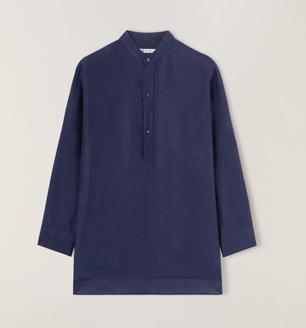
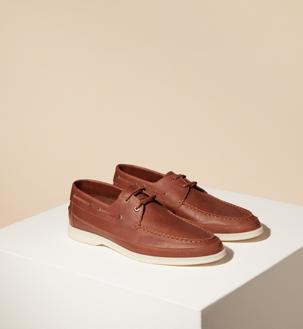

Dolce&Gabbana and Pelayo Diaz present a Special Collection featuring five new prints
Dolce&Gabbana have unveiled a new Special Collection in collaboration with Pelayo Diaz, featuring five exclusive themed prints.
Considered among the bloggers and influencers who pioneer the new digital phenomenon, Pelayo has always nurtured his passion for fashion and style in a very personal and particular way. This has led him to become one of the most followed and appreciated personalities in the fashion industry.
Pelayo Díaz Zapico, a native of Oviedo, Spain, was born into an affluent family and graduated from Central Saint Martins, London. In 2007, he launched his fashion-focused blog called “Katelovesme.” After a slow start, the blog gathered momentum when Pelayo began collaborating with leading luxury brands. In 2011, he released his first collection called “Nobody Knows.”
By 2014, Pelayo had become a leading fashion influencer on social media, where he had amassed more than a million followers, as well as making his debut on television. He was also a regular on the catwalks and photo shoots of major brands. Pelayo’s relationship with Dolce&Gabbana began in earnest in 2017, when he appeared on the brand’s catwalk in Milan.
The longstanding relationship between Pelayo and Dolce&Gabbana brings to life a Special Collection inspired by his childhood memories, his most beloved places and the sensations that accompanied him throughout his career, from





his youth to his fashion studies. The special Pelayo collection is anchored by five themes, that materialize his memories in five new and exclusive prints.

The first of these feature porcelain cups and plates in a kaleidoscope pattern, evoking the intimate and familiar dimension of breakfast at home. The multiform shell pattern recalls the hidden beaches of the Asturias region of Spain. A third pattern recreates the large wardrobes from Pelayo’s family home in Oviedo, which have colourful landscape paintings as door decorations.
‘Postcards from Ribadesella’ celebrates the beauty of this fishing village in Asturias and its casas de Indianos - historic mansions built by affluent Spanish migrants returning from South America, who were known locally as Indianos. The fifth print, exploring the region’s popular devotion to Virgen de Covadonga, features patterns in sombre black and white tones.
The Special Collection includes pyjamas, shirts, bermuda shorts and robes in habotai silk with an all-over print. It is refined with details such as contrasting piping. This collection is available at the Dolce&Gabbana boutiques in Milan, Madrid, Puerto Banus, London and Miami.

Gucci’s expansive exhibition celebrating 70 years since the creation of its iconic Horsebit Loafer
During the Gucci Spring-Summer 2024 Men’s Collection at Milan Fashion Week, Gucci presented an expansive exhibition in celebration of an icon: the Gucci Horsebit Loafer. Titled Gucci Horsebeat Society, the immersive event marked 70 years since the creation of the emblematic Horsebit Loafer through installations featuring ten international artists, designers and creatives. The exhibition also formed the setting for the static presentation of the Men’s SS24 Collection.
The exhibition was brought to life at Spazio Maiocchi, the multi-faceted exhibition space where art, design and fashion blend in a former industrial building of over 1000 square meters in central Milan. Curated by Alessio Ascari, the Milan-based creative director and curator of Spazio Maiocchi, the exhibition was a multi-disciplinary experience exploring the iconography of the Horsebit Loafer through a combination of fashion, art and audio-visual elements. This included a durational performance by the Spanish artist and choreographer Candela Capitán, and a program of DJ sets by the renowned Parisian electronic music label Ed Banger.
Conceived by Aldo Gucci in 1953 as a loafer embellishment, the Horsebit - a miniature of the metal clamp of a horse’s bridle - has become a universal emblem for Gucci. As a signifier of the community embodied by the House, it has been interpreted over seven decades in hardware and motifs across accessories, jewellery and ready-to-wear.
Tracing the Horsebit to its equestrian roots, the Gucci Horsebeat Society re-imagines the tradition of the country club in a contemporary space fused with the spirit of artistic counterculture. The concept materialises in a multi-dimensional ‘house’- a series of sensorial, quasi-domestic environments inhabited by specially commissioned artworks.
In a diverse curation, the works of the ten artists - whose individual practices span from applied to digital artswere displayed in unexpected dialogues with one another, providing an abstract and innovative take on the timeless Horsebit emblem.
In the courtyard of the Spazio Maiocchi, the Brooklynbased Russian architect and multi-media artist Harry Nuriev from Crosby Studios created a conceptual ‘patio’ employing the Horsebit in furniture design, while the Italian visual artist Anna Franceschini curated a ‘cabinet of curiosities’ centred on artefacts from the Gucci archives.
Opening onto the courtyard, a ‘bedroom’ space unveiled a visually arresting image by the American photographer Charlie Engman, complemented by the only historical artwork in the exhibition: the 1998 installation Bedroom Ensemble II by Swiss artist Sylvie Fleury. The work was contextualised with a new Horsebit-pattern wallpaper designed especially for the exhibition, setting a suggestive stage for Tom Ford’s red Horsebit pump from the Gucci Fall-Winter 1995 Collection.
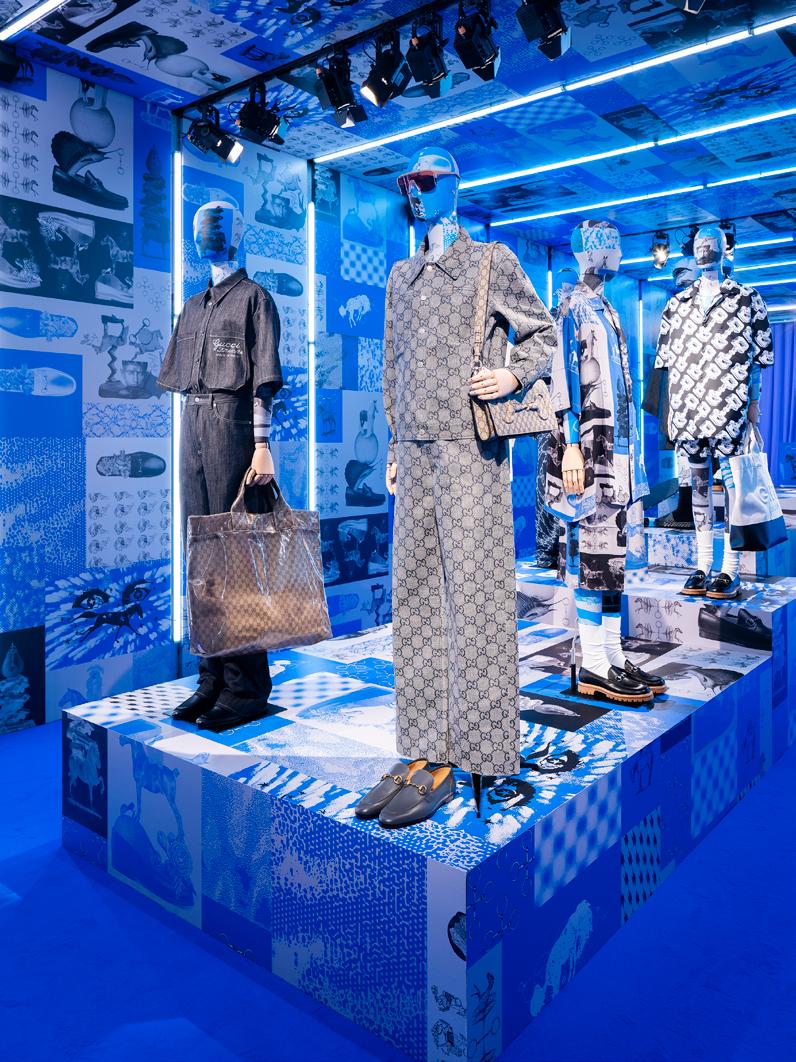
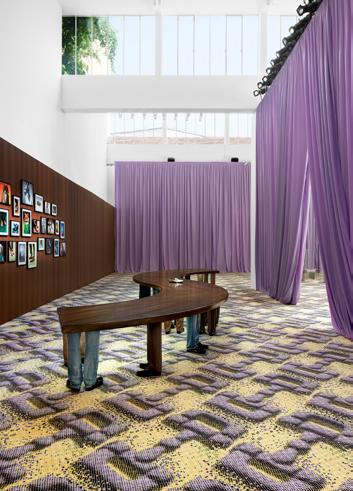
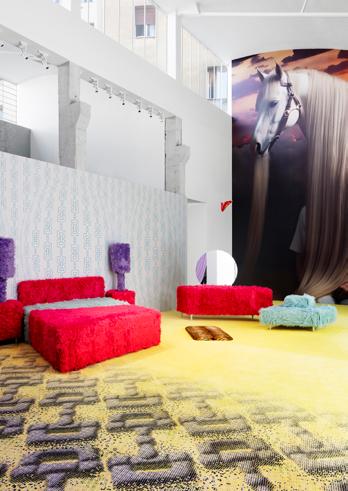


In the main gallery space, visitors were met by a theatrical ‘dining room’ featuring a surrealist table designed by the American sculptor Pitterpatter, and a quadreria of fantastical creatures by the Canadian digital artist Blatant Space. In the cinema room, a film by the British photographer and filmmaker Bolade Banjo traced the trajectory of the Horsebit through historical imagery and contemporary footage.
Guests were invited to immerse themselves in the viewing experience in a dark space punctuated only by ‘light sculptures’ created by the South Korean designer Gyuhan Lee, reinterpreting the Horsebit motif in the tradition of hanji paper making.

As reflected in Gucci’s archival imagery, upon its launch in 1953, the casual but elegant Horsebit Loafer became reflective of a changing, more liberal mentality towards conventional
dress codes. In the 1960s, it assimilated into the wardrobes of cultural icons and stars like Francis Ford Coppola, Fred Astaire and Alain Delon before a new generation of teenagers appropriated it in the 1970s, including a skateboarding Jodie Foster photographed in 1977.
In the 1980s, it was adapted by a tone-setting culture of career women before its appeal was reshaped in line with the sensual, sophisticated language of Gucci in the 1990s. Through the House’s sumptuous lens of the 2010s, the Horsebit would grace a new classic in the shape of the shearling-lined Princetown slippers.
Aptly, it is in the ‘closet’ - a space covered floor-to-ceiling in a collage wallpaper created by Australian image-maker Ed Davis – that the Gucci Spring-Summer 2024 Men’s Collection was showcased on mannequins.


For this Autumn, Berluti has unveiled four new patina colours, and a new casual sneaker called Trainer
For the upcoming Fall-Winter season, Berluti has curated four new colours - Grapes, Mimosa, Opuntia and Osso - from the patina book for its iconic Jour leather goods line. These four new patina colours will be available in Berluti stores worldwide only till November. The brand has also unveiled a new casual sneaker called Trainer.
Inspired by the warmth and richness of red wine, Grapes echoes the subdued, secret atmosphere of a gentleman’s club. The colour is available in a wide range of Jour bags, from the classic Premier Jour cross-body bag and E’Mio Scritto briefcase to the new Taglio line - including the Un Jour,

Toujours, Nino and Jour Off styles, complete with distinctive cut-outs that bring a particular depth to the patina.
Blooming just in time for the Fall collection’s drop, mimosa is one of the exceptional few flowers that thrive during the colder months. Its subtle, honey-like perfume and its luxurious yellow colour inspired this bright patina that brings light to the Un Jour Scritto Swipe briefcase and the Premier Jour Gulliver cross-body bag.
Taking its name from the distinctive pear cactus, Opuntia takes on an intense green colour that is both daring and versatile. Unconventional by nature and suited for the colder

Winter months, this patina is available in Scritto Jour styles, including the Toujours Mini and Toujours XS totes, the Premier Jour Mini cross-body bag and the Nino clutch. It is also featured on the Scritto Swipe version of Un Jour, E’Mio Gulliver and the Working Day backpack.
With its delicate ivory shade with golden undertones, Osso is inspired by raw natural elements. Particularly transparent, this patina requires exceptional know-how and material quality, as it reveals all the attributes of the leather underneath. Timeless yet unique, it is featured in the Toujours XS Scritto and Toujours Gulliver Scritto totes.

Berluti is expanding its sneaker collection for the FallWinter 2023 season with Trainer, a casual sneaker with a slim outsole. A fresh take on retro Olympic sneakers, Trainer’s outlines are pure and minimal, and feature suede or mixed materials uppers complete with a patinated calf heel tab and tongue. Supple and light, its texturised rubber outsole embraces the natural curves of the foot, for better comfort. Hand-stitching, laces and soft and supple calf leather linings complete the details.

Two different styles are available. One is slightly colourcontrasted calf leather, with a suede toe cap featuring a discreet embossed Scritto motif. The other style is in full suede - navy or khaki - with contrast stitching.

Guerlain has added three new perfumes to its flagship Aqua Allegoria collection: Nerolia Vetiver Harvest, Rosa Rossa Harvest and Mandarine Basilic Harvest. All three, conceived by Perfumer Delphine Jelk, are dazzling allegories of nature that showcase and enhance the scents of its natural raw materials. These three are also emblematic of the house’s commitment to sustainability.
Guerlain has been creating exceptional fragrances and beauty products since 1828. In 1999, Guerlain unveiled its Aqua Allegoria collection. One of the signature collections of the house, its fragrances are loved for their simple yet beautifully refined set of olfactory codes. Avant-garde and ambitious at the time of its launch, Aqua Allegoria’s elegantly joyful fragrances are woven from ingredients of natural origin, selected by Guerlain’s perfumers from select gardens across the world.
In 2021, Guerlain became a member of the non-profit organization Union for Ethical BioTrade (UEBT) - an internationally recognized non-governmental organization
which establishes ethical sourcing standards and practices. Through its UEBT membership, Guerlain has dedicated itself to evaluating the supply chains of its 40 most emblematic ingredients. The goal is to ensure “the most ethical and sustainable sourcing of natural materials, while respecting biodiversity and protecting the rights of workers and communities.”

In 2022, Guerlain integrated the Aqua Allegoria collection into its sustainability and biodiversity commitment. However, the house was already set in that direction. The ingredients used in the three new additions to the collection stem from relationships that have been forged with sustainable and responsible suppliers over several generations.
From Calabria, where honey, mandarins and neroli is sourced, to Isparta in Turkey and Kazanlak in Bulgaria where beautiful Damask roses grow, Guerlain works with its suppliers to improve each sector of production. Through this approach, Guerlain aims to achieve “Sourcing with Respect” certification across all of the House’s supply chains by 2026.
On Calabria’s Ionian coastline, the springtime scent of orange hits the senses long before any groves come into view. As the small white neroli flowers dot the branches of orange trees, filling the air with their delicate fragrance, hundreds of bees begin to forage and transport the precious nectar to Guerlain’s hives that sit among the citrus groves.
Using this exclusive honey, sourced from the same flowers that Guerlain’s perfumers use to source their citrus essences, Neroli Vetiver Harvest weaves new interconnections with the neroli flower. In order to reveal this honey’s elegantly floral and zesty orange blossom notes, for the first time, Guerlain has used resin columns to capture the scent molecules. Thanks to this innovative process, the resulting extract remains faithful to the subtle nuances of the source honey.

Perfumer Delphine Jelk has added this exceptional new honey note to Nerolia Vetiver Harvest in generous doses, along with neroli’s floral notes. This results in an eau de toilette with a new-found roundness, and a subtle yet tempting facet. Throughout, the nectar creates crossovers between its ingredients to create a fragrance of imbued richness.
Nerolia Vetiver Harvest’s top notes underscore the floral inflexions found in neroli. When enveloped with honey’s sweetness, neroli fluctuates between the orange blossom’s radiance and its soft sweetness. At the heart of the fragrance, fig accord appears fleshier and plumper. Meanwhile, honey and vetiver base notes meld with the grapefruit inflexions in the vetiver. Combined, they leave an irresistible fragrant impression.
Each morning, as the landscape turns pink with flowers that have bloomed overnight, expanses of roses glisten with the dew stretch out towards the horizon. As pickers enter the scene, roses expel their exquisite fragrance, creating a magical moment for the harvest to begin. Using techniques that have remained unchanged for centuries, pickers detach each head from its stem with a click. Tumbled into aprons and ready for the still, the roses are then whisked away in large canvas bags as speedily as possible so all their glorious freshness can be retained.
For Rosa Rossa Harvest, Delphine Jelk has added a new rose facet to the original Rosa Rossa eau de toilette - an exclusive organic rose water from Grasse made from distilled Centrifolia rose, the jewel of the Grasse region.
Used to dilute the perfume concentrate instead of the standard purified water, this fresh rose water brings a new facet to Rosa Rossa’s signature composition.
Rosa Rossa Harvest recreates the complex and delicate scent of a freshly picked rose. As the scent of rose gradually unfurls on the skin, the acidity of rose petals is revealed through the vegetal notes of blackcurrant, blackcurrant stem and lychee accords.
When warmed by the sun, rose fragrance becomes thicker and heavier. To express this rich characteristic, Delphine has combined the fruity, almond inflexions of Bulgarian rose essence with the honeyed accents of Turkish rose essence. Once accented with sandalwood, benzoin and musk, the rose embraces the skin with more splendour and facets than ever before.

An iconic citrus fruit from the sunny landscapes of Calabria in southern Italy, the mandarin offers an unexpectedly nuanced palette. Unlike other mandarins, Marzolo mandarins ripen in March, so that in November their still-green zest gives off a slightly bitter fragrance. It’s this precise scent that piqued Guerlain perfumers’ interest.

Harvested by hand, Marzolo mandarins are sent straight from the tree to the machines used to extract the essential oil in its peel. By firstly pressing the mandarins between two rollers before crushing them, the resulting mandarin juice is centrifuged to create a pure essence.
This mandarin essence takes the dramatic lead among Mandarine Basilic’s ingredients, while the fresh, green summeriness of basil essence creates a contrast to mandarin’s zestiness. The result is a freshly dynamic and exhilarating
reworking of the original eau de toilette’s aromatic and citrus ingredients. As addictive as it is electrifying, Mandarine Basilic Harvest brings a brand new bittersweet flavour to the Aqua Allegoria collection.
Inspired by Guerlain’s iconic “Bee Bottle,” the new Aqua Allegoria bottle is made in France from 15% recycled glass. For Aqua Allegoria Harvest, the Bee Bottle comes decorated with a colourful cotton cord and tassel seal echoing the three fragrances’ original designs. These bottles are presented in 100% recyclable, plastic-free cellulose covers produced from natural virgin-wood fibres from eco-managed forests.
Featuring a decorative flower and wheat motif by artist Laura Gulshani, each packaging cover showcases a colourful harmony of three shades, which together evoke a floral watercolour. The joyful result makes for a sophisticated yet simple eco-friendly cover that remains faithful to the Aqua Allegoria spirit.
Winchester, reimagined is a mechanical clock in the guise of a replica Winchester rifle
Winchester, reimagined - the result of the third collaboration between The Unnamed Society and the famed Swiss clockmaker L’Épée - is a mechanical clock in the guise of a replica Winchester rifle. This limited edition objets d’art does not shoot bullets, but mimics the original in terms of dimensions and some of the mechanisms, and comes with a seemingly endless catalogue of customisation options.
The Unnamed Society, founded in 2019 in Switzerland, is a team of passionate inventors, designers and artisans who “conceive the impossible and then make it a reality.” In the short time it has been around, this collective has built up a small but impressive portfolio comprising some of the most desirable objets d’art collectables.
For those familiar with watchmaking, L’Épée needs no introduction. Generally considered the best specialist clockmaker in the world, L’Épée has an illustrious track record in making clocks with unusual designs, both individually and as part of collaborations.
The “Winchester” is the second gun-as-a-clock concept collaboration between The Unnamed Society and L’Épée. The first collaboration gave us ‘Colt by The Unnamed

Society’ – a reinterpretation of Pancho Villa’s Bisley Colt. Then came ‘Golden Boy Winchester Clock’ – the first life-size reinterpretation of the Winchester rifle. According to The Unnamed Society, “following the resounding success of the first [Winchester] collaboration... demand had been growing for a follow-up.” Thus, we have Winchester, reimagined.
The second incarnation of the Winchester clock offers an exceptional choice of materials, colours and textures - allowing for every nuance of self-expression. The sleek, powerful lines have a certain freshness.
The choice of metals includes variations of steel, goldplated, black chrome, and a selection of bicolours, such as gold-plated and steel. Likewise, the stock and forestock provide the canvas for exploring new material combinations that are rare and exotic: alligator, taurus, kangaroo, snake, lamb, shark, lizard, stingray, bloodwood, walnut, rosewood, oak and ebony, to name a few.
The spectacular juxtaposition of materials and textures is matched by the painstaking craftsmanship that goes into the smallest detail. As a nod to the tradition of great gunsmithing, the receiver is engraved. As an alternative to
the classic arabesque motif, we have a modern interpretation of gun engraving by master bladesmith and knife designer Tashi Bharucha.
The original Winchester lever action repeating rifle introduced in 1866 was a game changer by its approach to loading ammunition, cocking the hammer and chambering the bullet in one rapid, fluid motion – with a lever actioned by the trigger hand. This allowed for excellent handling and accuracy, even without much prior training.
By 1866, the L’Épée had already been making precision clocks for 21 years. In the twenty-first century, L’Épée is creating a unique timepiece, in the silhouette of a Winchester, in its workshops in Delémont, in the heart of the Swiss Jura mountains.
The idea was never to bolt a clock to a gun. L’Épée reengineered the original’s hallmark loading and cocking mechanism to wind the timekeeping calibre and rethought its barrel system to indicate and set the time. On the original, the ammunition capacity without having to reload the magazine was 15 rounds. It is only logical for Winchester, reimagined to take 15 cocks of the lever to fully wind the mechanism, and generate a power reserve of approximately seven days.
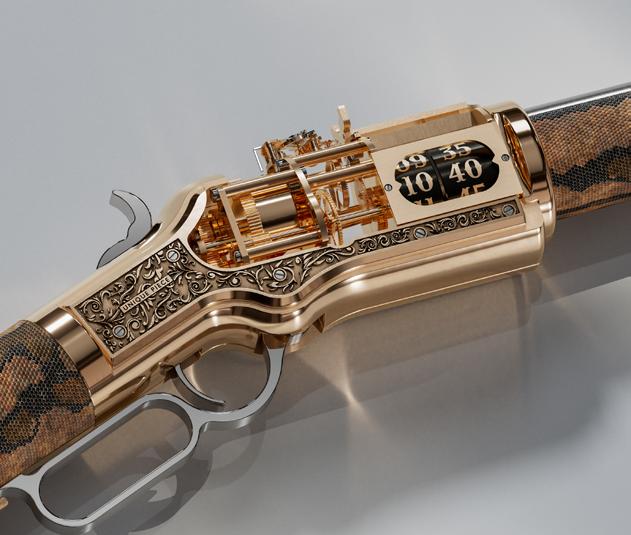
Arnaud Nicolas, CEO of L’Épée, says: “Working together with The Unnamed Society was a dream come true, especially in terms of finding creative engineering solutions to address the countless challenges of ‘Winchester, reimagined’. These ‘timepieces of art’ offer a unique combination of watchmaking excellence and artistic expression, one that challenges and inspires the imagination from every angle, with every reflection of light on these daring creations.”
Winchester, reimagined is presented in a case finished in the finest leather. The bespoke stand, crafted from rich walnut, allows the “gun” to be displayed to the fullest effect on a table, desk, mantel or wall.
From the mounting anticipation as you behold the magnificent leather case to the gratifying feeling of beholding something truly exceptional, and watching, mesmerized, as the light reflects off the masterfully worked materials, surfaces and textures – every facet of Winchester, reimagined is carefully and subtly thought-through.
Winchester, reimagined is a Limited Collection of 87 pieces, each one is a one-off creation with its unique juxtaposition of precious and unexpected materials, textures and colours.
Beosound A5, B&O’s new portable speaker designed in collaboration with GamFratesi
Bang & Olufsen’s new Beosound A5 portable speaker was designed in collaboration with the Danish-Italian design duo GamFratesi. Available in two colourways, it embodies a fusion of northern and southern design cultures while possessing B&O’s high-quality sound, technology and craftsmanship.
“Beosound A5 is our new high-end portable speaker which combines Bang & Olufsen’s long standing approach to timeless design with our vision on sound for the future,” says B&O’s VP of Product Marketing, Michael Henriksson. “We’re excited to collaborate with GamFratesi for the first time, to create two speaker designs that are rooted in a Scandinavian aesthetic with a distinct design signature on their own.”

Beosound A5 is available in two colourways. One is in natural aluminium with a woven paper fibre front and a light oak handle, invoking a feeling of the laid-back Scandinavian summers. The second colourway is in black anthracite aluminium paired with a dark oak wood speaker cover and handle. This version seeks to evoke the aesthetic of winter woodlands. Both finishes can sit beautifully inside a home or outside in nature.
“Our inspiration for Beosound A5 came from many places including the iconic Beolit series as well as natural materials synonymous with the colours and textures found in Scandinavian nature”, says a statement from GamFratesi. “From the traditional Panama straw hats worn on beaches, to the handwoven leather accents of Danish chairs from the 1960s, blends of natural materials applied in experimental ways guided our design journey.”
Based in Copenhagen, GamFratesi studio was founded in 2006 by Danish architect Stine Gam and Italian architect Enrico Fratesi. The studio takes its creative drive from a fusion of tradition and renewal, with an experimental approach to its chosen materials and techniques. With their dual traditional background, Gam and Fratesi draw on the classic Danish furniture and craft tradition as well as the classic Italian intellectual and conceptual approach.
The soft organic curves and natural materials of Beosound A5 reference the curved edges and handle from Beolit 607 launched in 1961. The wooden teak finish of the Beolit 800 and Beolit
1000, originally designed by Jacob Jensen between the late ‘60s and early ‘70s was also influential in GamFratesi’s design process for Beosound A5.
While Beosound A5 takes its aesthetic inspiration from the Beolit series, on the technical side it draws inspiration from the class-leading Beolab 90 and 50 hi-fi speakers. Beamforming technology, an innovation first built into the Beolab series, has been brought to Beosound A5 to control the sound with high precision. This creates an immersive experience far beyond the expectations of a portable speaker.
According to B&O, Beosound A5 is its most powerful portable speaker to date. Its four-way driver setup with four digital amplifiers provides a combined 280 watts of power. Comprising of 1 x 5.25” woofer, 2 x 2” midrange and 1 x ¾ tweeter, Beosound A5 can fill large rooms with dynamic 360-degree sound. It is controlled by either a sleek user interface or directly from the Bang & Olufsen App.
Although the Beosound A5 is classed as a portable speaker, in reality, it sits at the junction where portable and home audio meet. The solid oak handle allows the speaker to be carried from room to room with ease, whether placed on the floor, shelf or table. Thanks to an IP65 water and dustproof rating, Beosound A5 can also be taken outside. It has more than 12 hours of playtime and a wireless phone charger integrated into the top panel of the speaker.
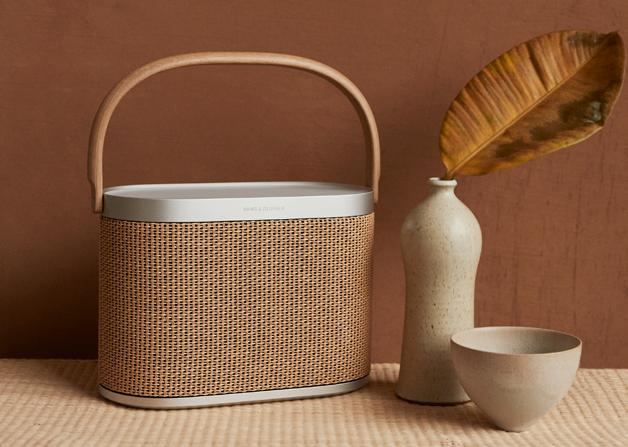
Beosound A5 has been modularly designed so that it can be easily serviced and repaired to extend its lifetime if needed, instead of being replaced by a new speaker. B&O
has also stated that it will continue to produce the easily exchangeable front covers in new materials and colourways so that Beosound A5 can evolve with a customer’s style and identity. These design elements ensure a long lifetime. However, once a Beosound A5 does reach its end-of-life point, the ease of disassembly and use of high-quality materials for structural components supports circular solutions.
Thanks to B&O’s Mozart software platform, the longevity of Beosound A5 goes beyond physical craftsmanship and modular design. Mozart provides the most up-to-date features across audio, connectivity, and software design, further ensuring that a Beosound A5 has the capacity and capability to evolve with new technologies.
The Mozart platform also allows two Beosound A5s to connect with each other in a stereo system or any other Mozart-enabled speaker in Bang & Olufsen’s portfolio. Furthermore, it can integrate smoothly into a Bang & Olufsen smart home system, creating an immersive multiroom experience at the tap of a button.
Mozart’s future-gazing capabilities and the introduction of ultra-wide-band will, according to B&O, unlock new features over time. One such feature is Proximity Pairing, which will automatically connect two Beosound A5s when they are placed near each other.
Beosound A5 is compatible with Beolink Multiroom, Airplay 2, Chromecast, Spotify Connect, Bluetooth 5.2 and more.
Hermès Home Collection explores the minimalism aesthetics in its extreme
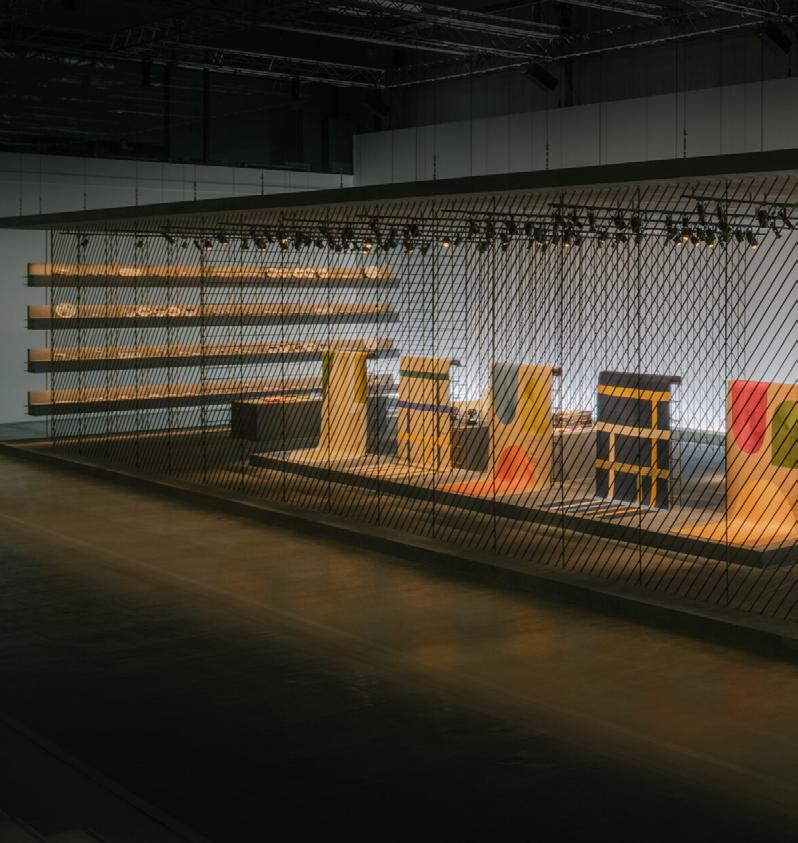
The visual aesthetics of Hermès’ creations for the home, presented at Milan Design Week 2023, are drawn from a form of archaism and minimalism. The very staging of the event seems to scorn all excess, presenting a geometric framework composed of iron rods and concrete, resulting in an interplay of grid and lines.

For the furniture presented, strength is revealed through removal, and clarity is obtained through subtraction. Know-
how is demonstrated through exceptional elements: blown glass for the minimalist lamps, traditional upholstery for the simple, refined chair, and virtuoso hand embroidery for the rugs.
A preference for organic materials is in evidence by the use of bronze, glass, wood and leather, showcased in their most elemental manifestations. The muted colours play their part in expressing motifs that pay tribute to the house’s heritage, as do equestrian references on the rugs and blankets.
Conceived by Danish designer Cecilie Manz, the Ancelle d’Hermès armchair is compellingly direct. Its powerful frame in solid wood is combined with a sheet of leather that creates a light and elegant seat. Heir to a Scandinavian tradition that merges robustness with minimalism, this armchair offers an elegant, structured look.

Inspired by the house’s archives, the motifs on the cashmere plaids represent jockeys’ silks embroidered together in colourful contrasting yarns that intermingle to create a unique pattern. They are hand-spun and hand-woven, using multiple shuttles or the ikat technique depending on the model. Exceptional craftsmanship is combined with a meticulous blend of graphics, assembly and bold colours.

A chair with an angular, geometric look, sheathed in leather by Hermès in the 1930s, inspired Jasper Morrison to reinterpret it with a light touch. By making the legs slimmer and revising its proportions, the designer has imbued it with modernity. The exceptional leather sheathing of the seat and backrest were faithfully replicated, as was the glossy, glazed heritage leather developed for this creation. The result is a fusion of history, know-how and contemporary attitude.


Pommel horses, fence poles, race tracks and horses’ heads are displayed on these new rug offerings in designs by Pierre Charpin. In an interplay of graphic lines and emblematic colours, the rugs demonstrate the Cordélie cording technique, creating material effects through the precise placement of a cotton cord embroidered onto a linen base. Hand-embroidered, this textile signature is unique to Hermès.
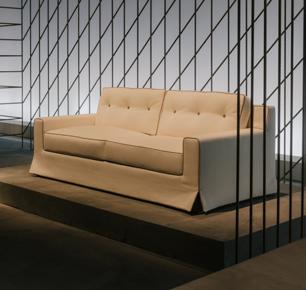
Archetypal, timeless and inviting, the Contour d’Hermès sofa puts textiles in the limelight. Upholstered in a wool and cotton slub canvas, it features discreet references to Hermès’ leather-crafting heritage. The buttons that punctuate the cushioned backrest and the piping that emphasizes its lines are in leather. The legs hidden under the fabric are also leather sheathed and burnished.
The Souffle d’Hermès lamps, by Finnish designer Harri Koskinen, explore the material nature of glass. They are equally fascinating whether switched on or off. They fulfil a function, assert their familiarity and transparency, and embody simplicity and strength. In blackcurrant, fern or burnt orange, these lamps express the magic of the glass blower’s art.
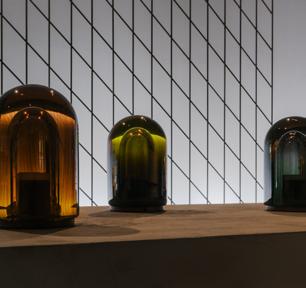
Chef Akmal Anuar, a Michelin star chef and recipient of Bib Gourmand, has accrued over 20 years of culinary experience, both in the kitchen and in management, and has collaborated with renowned chefs like Dan Hunter, Luis Andoni Aduriz and Yasuhiro Sasajima.
Born in Singapore, he started his professional journey at an early age by helping out at his parent’s hawker stall, then went on to become the Head Chef for over seven years at the famous Iggy’s Restaurant in Singapore. While at Iggy’s, recognized in the prestigious World’s 50 Best Restaurants, Chef Akmal served famous dignitaries and celebrities, including the late Lee Kuan Yew, Singapore’s founding father.
In 2014, Akmal moved to Dubai and joined the Starwood Hospitality Group. The business and management essentials he learned to run food and beverage operations gave him the confidence to set up White Rice Consultancy. Offering food and beverage consultation, concept creation, brand management and joint venture, the company is involved with projects now underway in the UAE and Singapore. One of these is his collaboration with Sunset Hospitality Group, a leading hospitality and management company in Dubai, to open Goldfish Sushi & Yakitori.
Chef Akmal, who has a loaded calendar these days, was kind enough to have a conversation with us recently about his life experiences and his Goldfish Sushi & Yakitori venue.
Chef Akmal, your culinary journey began at an early age, helping out in your parent’s hawker stall. What functions did you perform in the business over the years? How did your experience in the family business lead to a career in the culinary arts?
As the eldest child, I began at my parent’s company in 1992. Those days were the pre-internet era, and my experiences were sensorial. I had a hands-on experience with every aspect of the job, which helped me sharpen my mentality and allowed me to be truly dedicated. Initially, pursuing a career in culinary arts wasn’t what I intended to do. It was during my professional experience in European kitchens that my passion for cooking was ignited.
You were Head Chef for over seven years at Iggy’s Restaurant in Singapore. Tell us about your journey from a novice to Head Chef of a worldrenowned restaurant.
I joined Iggy’s as a Junior Chef in 2006, and had a reporting line at the time. I was an aspiring chef and wanted to do new things. I loved reading cookbooks from famous chefs, and would often try out their recipes and inspiring techniques. I wanted to build a strong skillset and learn cooking tricks to stand out. My momentum was good, and all my focus was on creating unique dishes. My bosses were very supportive throughout my progression, and somehow gave me a platform to shine.
The owner of Iggy’s Restaurant, Ignatius Chan, had an amazing palate. He was well travelled and knew what was successful at the time. At one point, I began to create signature dishes that have never been done before, and the patrons soon realised this. Slowly, I climbed up the ranks and eventually became Head Chef. From then on, the restaurant won accolades after accolades. It was a 7-year journey filled with growth and success.
A conversation with Michelin Star Chef Akmal Anuar, the man behind Dubai’s Sushi & Yakitori Restaurant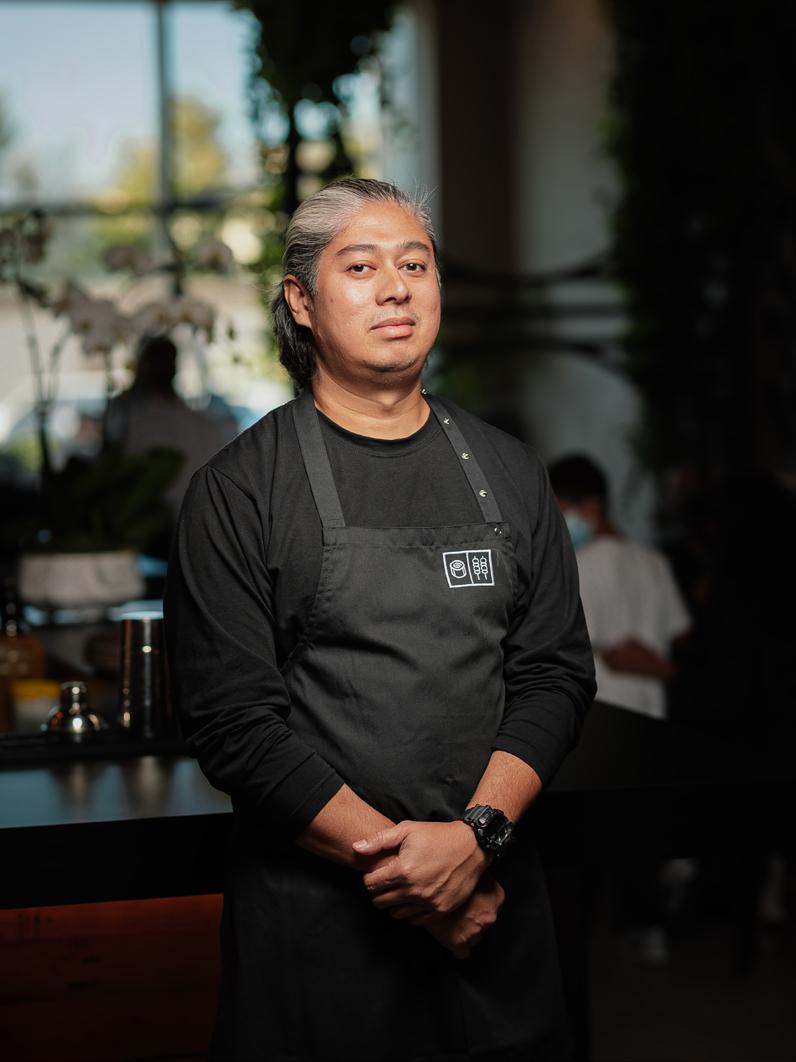

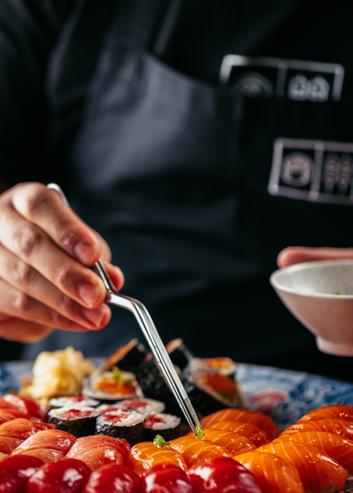

Could you give us a sense of what it’s like to be the Head Chef of a restaurant that caters to celebrities and heads of state, and how this experience has helped shape who you are today?
Celebrities and heads of state tend to visit specific places for a particular reason. Most likely, someone spoke highly of their experience, and recommended they visit. At Iggy’s, I recall them having very interesting demands, and I tried to always accommodate that. Providing this tailored approach to customers really helped our restaurant stand out. The staff were very excited too when we had such visits. As we got used to this, our confidence and motivation grew bigger. Experiences like this really build charisma.
Why did you choose to participate in culinary exhibitions and competitions over the years? How has it benefited you, and would you recommend it to aspiring chefs?
I’m typically not a competitive person, however, I did participate in one competition back in London Salon Culinaire, where I received a bronze award for the first time. I also took part in a few exhibitions in Paris with Pierre Hereme in Musee Dorsay, in addition to a presentation in San Sebastian Gastronomica in 2011, alongside great chefs like Heston Blumenthal and Grant Arcatz. While these were great experiences, I’d say competitions
generally don’t matter to me. I’m a simple man who is all about execution. To aspiring Chefs, my advice would be to focus on your own goals and execution, and the rest of the success will come along naturally.
In 2019, you set up White Rice Consultancy in Dubai. Why did you decide to move away from the kitchen and step into a managerial role?
In 2019, it was about time for me to step into a new role and take on a bigger responsibility. Being a chef is one thing, but learning to run a business is another. Having loyal staff that desired to grow really motivated me to provide them with the support to achieve that. I’m a family man too, and as my kids were growing, I needed to venture into something greater to sustain a better life for the future.
How did your collaboration with Sunset Hospitality Group to launch Goldfish Sushi & Yakitori in Dubai come about?
It was during the height of the pandemic towards the end of 2020, when I received a phone call to visit a location for a potential project. Before Goldfish was born, a Japanese restaurant was present in the same location where we were eventually given the opportunity to take over the space. After discussions with the heads of Sunset Hospitality Group, we made a swift decision to create a new Japanese concept.

Award-Winning celebrity Chef Izu Ani presents his latest concept Kai Enzo - Dubai’s newest rooftop restaurant, combining Japanese and Mediterranean flavours, at the Hyatt Centric Jumeriah in La Mer.
Kai Enzo’s menu seamlessly merges far-Eastern flavours with Western influences and draws upon the two region’s shared culinary philosophies - quality, freshness and simplicity. Conceived by Chef Izu and his creative team, the menu showcases a selection of Mediterranean and Japanese dishes that have been reworked for an elevated dining experience.
“This project holds a special place in my heart as it unites two cultures that I deeply cherish,” says Chef Izu Ani. “I wanted to create a concept that brings together the essence of Japanese and Mediterranean cuisines and that showcases their similarities and unique flavours.
“For me, food and cooking are all about storytelling. We don’t need to complicate things; we just need the confidence to let the food and flavours speak for themselves. I want people to come to Kai Enzo and fall in love with the whole experience in their own unique way so they can create their own Kai Enzo story.”
The word ‘Kai’ in Japanese means ocean or shell, which represents the calm setting of the restaurant, with views of the sea. The interior design is purposefully uncluttered so that guests can focus on enjoying the calm, beautiful atmosphere and not be distracted by busy surroundings. ‘Enzo’ means King or owner and represents the ingredients ruling the experience. Together ‘Kai Enzo’ connects effortlessly and is also the name of Chef Izu’s son, making this a very personal dining concept.
Highlights of the Kai Enzo menu include green bean salad with black goma and wasabi pea, tiger prawns with kimuchi butter and shisho pesto and Hokkaido scallops dressed in green apple ponzu and salsa verde. A wide range of sushi, sashimi and charcoal grills are also available. Desserts include a cherry blossom panna cotta with black sesame crumble and Hokkaido cheese ice cream topped with hazelnut crumble and roasted strawberry jam.
The curated cocktail menu is divided into two sections: Taiyo, which symbolizes the sun and captures the essence of the land of the rising sun and Kai, which represents the sea and showcases the beauty of the Mediterranean. Each section incorporates ingredients that embody the unique flavours and characteristics of their respective regions. Thus, the beverages in the Taiyo section include yuzu, shiso leaves, sake and matcha, while the Kai section offers drinks that feature a refreshing blend of citrus, herbs and oils.
Kai Enzo is designed to create a holistic dining experience, not just through its culinary offerings, but also through its ambience, music and vibrant atmosphere. Located on the rooftop of the Hyatt Centric Jumeriah in La Mer, Kai Enzo offers panoramic views of the entire Dubai skyline, as well as the Arabian Gulf.
The restaurant features fluid indoor and outdoor dining spaces and an interactive sushi bar which takes centre stage and forms the beating heart of the restaurant. The space also includes a lounge area and an outdoor terrace which will open after the summer months.
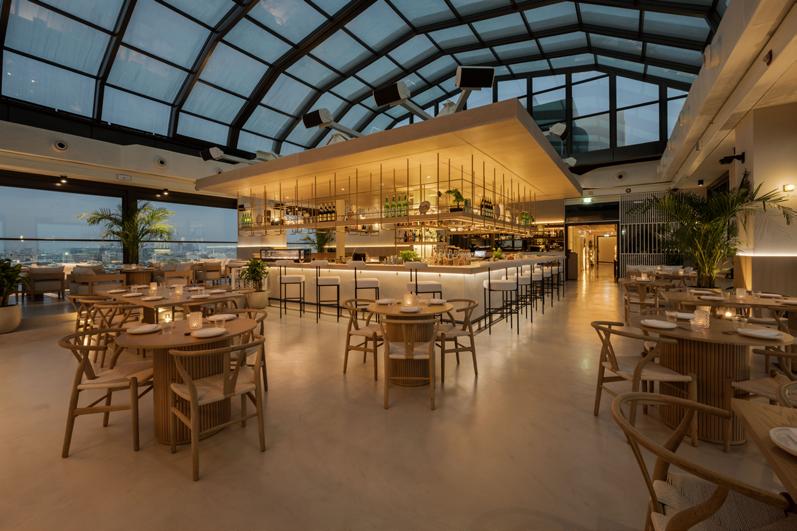
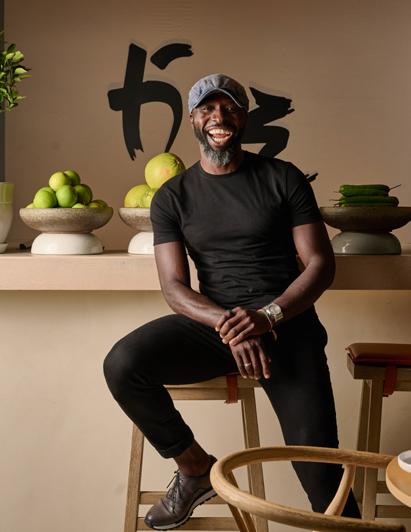

Signor Sassi, one of London’s most celebrated Italian restaurants, has started taking reservations for its imminent Dubai launch, scheduled for the end of September.
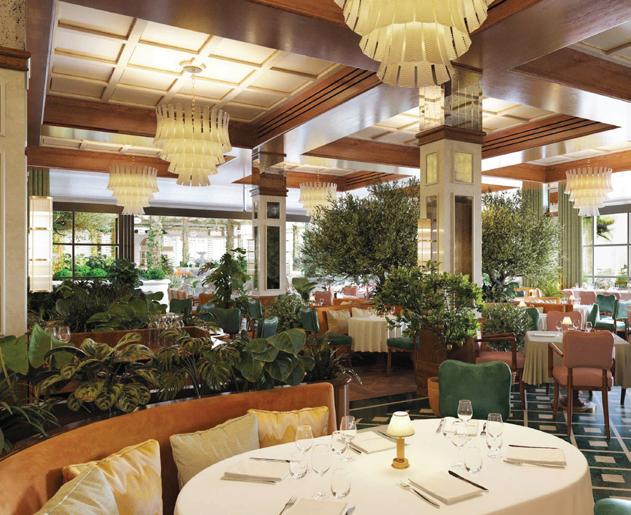
A joint partnership between Sunset Hospitality Group and San Carlo Restaurants, Signor Sassi is situated within St. Regis Gardens – on the rooftop of Nakheel Mall in Palm Jumeirah. Like its London sibling, the Dubai venue promises to offer an exquisite dining experience that combines Italian hospitality with a distinguished menu.
The venue’s layout and design, crafted to create an inviting atmosphere, draw inspiration from the luxurious villas nestled along the shores of Lake Como in Northern Italy. So expect to encounter coloured marbles, highly polished timbers, and an eclectic mix of designer furniture and décor elements.
Guests can anticipate a range of exquisite dishes, including signature offerings such as Lobster “alla Catalana” with Tomatoes and Onions, Avocado Bernardo Salad with Prawns, Lobster and Cocktail Sauce, Veal Milanese with Potato Sticks, Grilled Jumbo
Prawns with Fennel, Orange and Mullet Roe, Tagliolini with Caviar and Lemon Sauce, and Risotto “Signor Sassi” with Porcini Mushrooms and Truffle. Other Signor Sassi’s favourites include The Famous Spaghetti Lobster, Seared Veal Escalope, Braised Beef Short Ribs, and a delightful selection of artisanal pizzas, including Pizza with Burrata, Rocket and Truffle.
Signor Sassi will have two bars – one in the indoor restaurant and another on the covered terrace that will also feature a specially designed fountain. They will be manned by an Italian team specialising in the restaurant’s renowned selection of classic and specially crafted Italian cocktails. Among them, the signature Negroni, garnished with a classic orange peel. Wine connoisseurs will find delight in the extensive wine collection, featuring the finest Italian wines and a curated selection from around the world.
For the first month, the restaurant will be open for dinner service only from 6 pm to 2 a.m., with all-day dining available from October onwards.
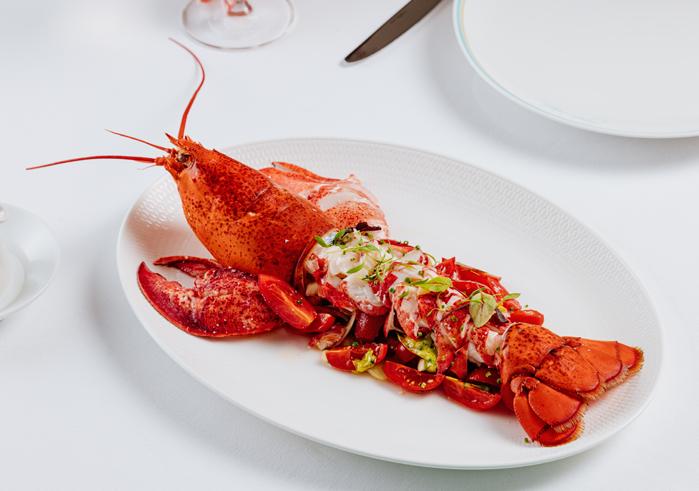

The all-new JW Marriott Masai Mara Lodge is a luxury safari resort sitting within the Masai Mara National Reserve in Southwestern Kenya, one of Africa’s most renowned wildlife and wilderness conservation regions. The lodge is a sophisticated and thoughtful sanctuary from which to explore natural vistas.
Exhilarating guided game drives offer guests the opportunity to observe the “Big Five” that Masai Mara is home to - lions, leopards, buffalos, rhinoceros, and elephants. Between June and September, guests of the reserve can witness the annual great wildebeest migration, which sees more than 10 million animals travel a distance of 2900 kilometres from the Serengeti in neighbouring Tanzania.
Bruce Rohr, Global Brand Leader, JW Marriott, said: “Offering our guests once-in-a-lifetime experiences and a deep connection to place, JW Marriott Masai Mara Lodge balances the thrill of a game drive with thoughtful opportunities to switch off and take it all in.”
The lodge’s elegant interiors, designed by Kristina Zanic Consultants, seamlessly blend the savannah inwards. Drawing inspiration from the elements, the design features soft, warm tones, natural materials and textures, and native colours thread throughout.
Each of the lodge’s 20 private tents provide a peaceful sanctuary to recharge and reset. Each features terraces overlooking the River Talek, a water source and habitat for many wildlife. The tented honeymoon suite offers a private plunge pool, while two interconnecting king and twin suites are ideal for families with children over the age of six - the minimum age of guests at the lodge.
The lodge is home to a number of thoughtfully designed spaces. The cosy Adventure Lounge is full of books to get lost in, and a space for young adults to take time for themselves. On the Cultural Deck, guests can gather around the fire pit to share tales of the day’s exploration.
The Spa by JW emulates the serenity of the reserve and offers tailored experiences and signature treatments which blend locally inspired techniques and therapies. These are complemented by natural and organic products by the premium African skincare brand, Healing Earth, which are also available as in-room amenities.
Guests can enjoy spa treatments from the comfort of their tented suite, accompanied by the sounds of the wilderness. Extending beyond body to mind and spirit with guided yoga, treatments include a ‘Masai Celebration’ incorporating local botanicals and therapies.
At the heart of the camp is the JW Garden - an outdoor space for guests to spend time discovering homegrown, organic ingredients, including the lodge’s signature rosemary. The garden’s produce is used by the lodge’s chefs to craft personalised dishes, cocktails, and mocktails. The garden will host daily programming, including live cooking, interactive cocktail mixology, and chef-led talks for a true farm-to-table experience.
A relaxing gathering place, Fig Tree Lounge offers panoramic views of the surrounding plains from the indoor and outdoor bar. It serves refreshing cocktails and mocktails infused with seasonal ingredients from the lodge’s garden.
An indoor and alfresco dining experience at Sarabi Restaurant takes guests on a nourishing epicurean experience guided by JW Garden ingredients and local culinary heritage. Guests can venture out into the reserve with the lodge’s guides to enjoy a freshly prepared ‘Bush Breakfast’ or dinner while sipping sundowners and soaking in the breathtaking savannah vistas. The lodge’s community programming provides an authentic insight into meaningful local projects, including The Maa Trust, an organisation empowering local people by promoting small business start-ups. The lodge donates a percentage of the nightly rate per person to the organisation and provides


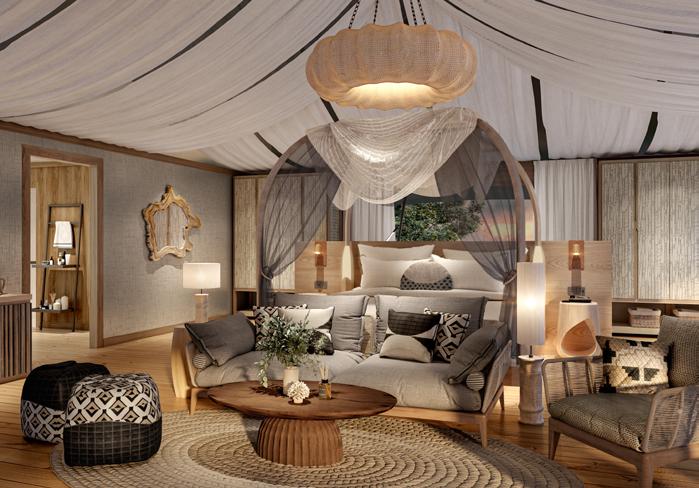
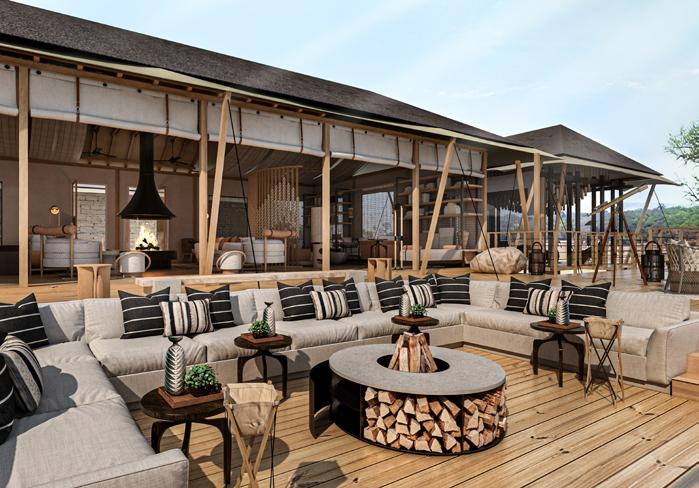
a space for craftspeople to retail Maa Beadwork and produce. Guests can visit The Maa Trust to meet with local artisans and forge a deeper connection to the people in the area.
Currently, 60 per cent of the lodge’s team are locals, with plans to reach 70 per cent, ensuring the hotel’s contribution to the socio-economic development of the region. As an ongoing initiative, JW Marriott Masai Mara’s Apprenticeship Programme invites young women from the community to diversify their skills and broaden their experience to kick-start their careers in the hospitality industry.
Partnership with the community began during the early development process of the lodge. Developed on land committed to a tourism project so as not to unduly disturb the surrounding environment, much of the construction was undertaken by local experts overseen by technical specialists, with build materials sourced from sustainable suppliers. The lodge has rehabilitated access roads to the property, installed power to the area, and provided access to clean drinking water for locals through a water treatment plant.
Emphasis on waste reduction and recycling is integral to daily operations. The lodge’s water treatment plant provides recycled and sanitised water. Food waste is placed at the lodge’s compost site and water wells are dotted around the lodge for animals to quench their thirst throughout the day.
By supporting local organisations such as The Mara Elephant Project and The Mara Protector Conservation Programme, JW Marriott Masai Mara Lodge contributes to protecting animals and their habitat across the greater Mara ecosystem.
Bringing a passion for the surrounding wildlife and nature to guests, the lodge’s Head Guide is a lifelong conservationist who holds talks about local culture at the lodge as well as guided walking tours. With an abundance of meaningful moments to experience at the lodge, guests can delve into photography and learn new skills at the lodge’s very own studio.
JW Marriott Masai Mara Lodge is a 30-minute drive from Keekorok Airstrip and a 25-minute drive from Sekenani Main Gate.

The Royal Commission for AlUla (RCU), as part of its ‘Journey Through Time’ master plan, will add to the accommodation offering in AlUla with Dar Tantora by The House Hotel. The new property promises to offer an immersive and authentic hospitality experience in AlUla Old Town. Dar Tantora will also house a pool, spa, restaurant and café.

The Royal Commission for AlUla (RCU) was established by royal decree in July 2017 to preserve and develop AlUla, a region of outstanding natural and cultural significance in northwest Saudi Arabia. RCU’s long-term plan outlines a “responsible, sustainable, and sensitive” approach to urban and economic development. It aims to preserve the area’s natural and historical heritage while establishing AlUla as a desirable location to live, work, and visit.
The RCU’s plans encompass a broad range of initiatives across archaeology, tourism, culture, education, and the arts. It has also committed to meeting the economic diversification objective, local community empowerment, and heritage preservation priorities, as outlined in the Kingdom’s Vision 2030 programme.
RCU is developing the 30-room landmark property by restoring several historical mud-brick buildings using a combination of contemporary engineering methods and time-honoured techniques. The development will showcase the Old Town village as a vibrant cultural hub.




The rooms will be adorned with traditional décor, furniture and artistic accents, incorporating storytelling elements that capture the area’s intangible heritage. Local artisans received specialised training to participate in the restoration work. This project reflects RCU’s comprehensive efforts to revive AlUla Old Town with tourism as the engine of development and job creation.
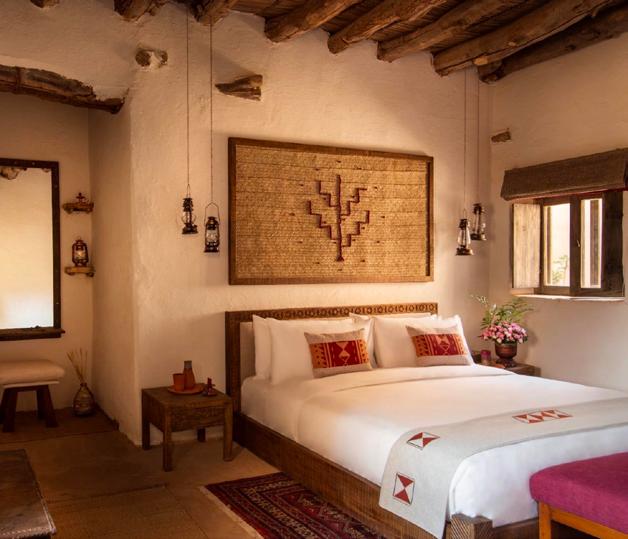
RCU has committed to sustainability objectives in its AlUla regeneration plans, including the Sustainability Charter that governs each project’s economic, social and environmental impacts. For delivering on this vision, AlUla Old Town was recognised by the United Nations World Tourism Organisation as a “Best Tourism Village” in 2022.
John Northen, Vice President- Head of Hotels and Resorts, Royal Commission for AlUla, said, “Dar Tantora by The House Hotel will allow guests to live the rich heritage of the AlUla Old Town historical village. Steeped in the past yet embracing progress, this hotel encapsulates RCU’s vision for a diverse range of accommodations as we continue to deliver on our plans for more than 5,000 keys by 2030.”


Ultima Gstaad, set in the upscale resort town of Gstaad, in the Bernese Oberland region of the Swiss Alps, has curated exclusive experiences for families this summer, particularly for those from the GCC region.

These experiences, set in the stunning beauty of Gstaad, include a venture into the mountains to discover the picturesque alpine lakes. This includes Lake Arnen, also known as the Pearl of the Saanenland. It offers idyllic views and a mountain-side restaurant. A fun-filled day at the Cailler Chocolate Factory leaves one surrounded by the sweet scent of chocolate. Guests can take a family electric bike excursion around Gstaad, or hire a pedalo to experience the tranquillity of the waters.
Following a day of activities, guests can spend some muchneeded downtime at the Ultima Gstaad Spa, with a hiking massage for the adults, and a “My First Massage” for the little guests. To end the day, guests can enjoy a family dinner at the Ultima Gstaad Restaurant, where Chef Andrea Franceschi will serve an array of delights presented in his signature creative style.
Alternatively, guests can take to the sky for dinner in a hot air balloon for an experience like no other. While on board,


families can enjoy a selection of typical Fondues Wyssmüller with various beverage choices. To end the meal on a sweet note, there are meringues for dessert.
Guests spending three days in the Signature Suite are invited to experience the “Recharge to the Full” wellness programme. It begins with an NDA test to allow the expert team to better understand each guest’s needs and requirements. Ultima Gstaad Spa’s latest technology and techniques mean that each guest’s well-being can be elevated to its optimum.
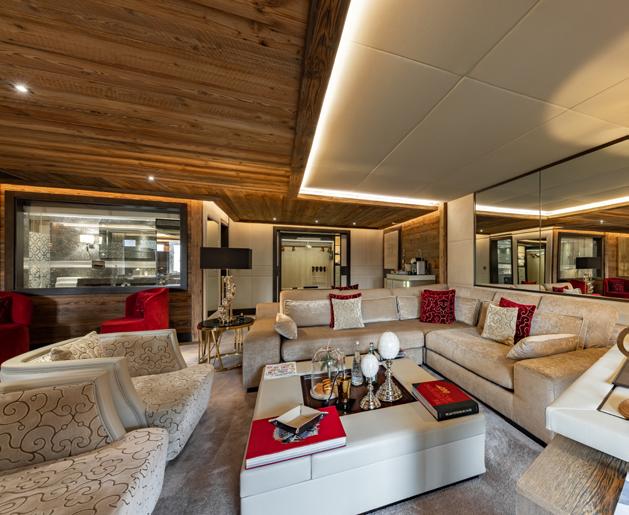
As the mountains provide an ideal setting for the best therapy, guests can spend each morning exploring Gstaad’s landscape, from following the hiking trails, to kayaking down the La Sarine, mountain biking across steep valleys and horse riding through the meadows.

These outdoor activities are followed by spa treatments: Ultima Signature Massage, The Legendary Facial to nourish the face and body, the Mountains Ritual, and an Immune Booster IV Drip in the state-of-the-art clinic. Guests are served locally sourced fish, meat and vegetarian creations by Chef Andrea Franceschi, all tailored to each guest’s needs and preferences.
The “Recharge to The Full” programme is the ideal combination of mountains, massage and clinic-based treatments to make guests feel truly recharged and renewed.
Alila Hinu Bay is a luxurious base from which to experience the Dhofar
Located an hour’s drive east of Salalah, on the shores of Mirbat, Alila Hinu Bay offers a luxurious home base to experience the Dhofar region’s refreshing Khareef monsoon season. Two to three hours by air from the searing heat of the major Gulf cities, the season offers misty drizzles, enchanting waterfalls, fresh green vegetation and a cooler climate for visitors to enjoy.
Set over 45 hectares of pristine beachfront property, with its own natural Lagoon, Alila Hinu Bay’s design draws on influences from its surroundings and Omani culture. The resort’s rooms and villas are situated along the natural contours of the resort, and frame idyllic views of the desert, lagoon or the Arabian Sea.
The one and two-bedroom accommodations have a luxuriously appointed modern aesthetic. The use of local materials, natural palette and floor-to-ceiling windows combine to create a fluid transition between the indoor and outdoor spaces. The resort’s expansive villas include a private pool and outdoor bathtub.
The resort’s Spa Alila, situated within a standalone building, is enveloped by the musky, woody scent of frankincense. Made from the resin of the hardy Boswellia tree, frankincense has been prized for its healing properties since the time of the ancient Egyptians. The finest frankincense, known as the hojari, comes from the unique microclimate of Oman’s Dhofar Mountains, and the city of Mirbat was once a prominent incense trading post.
The spa’s 150-minute ‘Timeless Frankincense Signature Escape’ treatment incorporates hojari frankincense with deliberately slow strokes to promote deep relaxation and stimulate circulation. In addition to other treatments, guests have the flexibility of designing bespoke treatments according to one’s personal needs and preferences after consulting with the in-house therapists. After the treatment,
guests can unwind further in the steam room, and refresh in the outdoor spa pool. Guests can also indulge in yoga or meditation classes.
The resort boasts two signature restaurants. Seasalt serves Southeast Asian cuisine, while The Orchard offers a menu inspired by the Frankincense Route. It features dishes from Oman through the Arabian Peninsula all the way to the Mediterranean, and an array of international specialities made with locally sourced ingredients.
Couples can also opt for a bespoke outdoor dinner at the resort’s SeaSalt Beach. This romantic dining experience under a starlit sky, serenaded by the gentle breeze, offers Omani, Asian or International dishes, specially prepared by the chef. The resort offers other bespoke cultural, dining and wellness experiences arranged by the resort’s Leisure Concierge team.
Guests of Alila Hinu Bay can admire the scenic landscapes of the resort’s vicinity while paddling across the calm waters of the adjacent lagoon. Family-friendly activities include clay art, mountain bike rides, searching for seashells along the shoreline or flying kites, among others. The Kid’s Club offers a range of weekly activities to keep the young ones occupied.
Not far from the resort, nestled among the nearby mountains, is the lush Wadi Darbat. Ranked among the most beautiful in Oman, the wadi has Darbat Lake situated at its heart, along with the nearby cascading waterfalls and caves. The lake offers short boat rides while its shoreline is the perfect setting for one of Alila Hinu Bay’s signature picnics.
The spectacular cliff face at the peak of Jabal Samhan stands at 1800 meters above sea level, and descends towards the coast by Wadi Hinna. The natural phenomenon of the ‘antigravity road’ is one not to be missed. These are just some of the nature-filled excursions that visitors to Dhofar can experience this Khareef season and beyond.



Manuka South’s Limited Reserve Range of Mānuka honey is rare and truly exceptional
“Manuka South presents the Limited Reserve Range honey from New Zealand. Considered among the world’s rarest and most luxurious, Mānuka honey is not only renowned for its rich flavour, but also for its exceptional health benefits.
Manuka South is a premium brand by the family-owned New Zealand Health Food Company, established in 1988. Manuka South’s stated mission is to be a “leader in offering premium Mānuka honey and bee products.”
Mānuka honey is harvested in isolated areas in New Zealand from the nectar of the Mānuka tree, which grows only in remote within New Zealand. Manuka flowers bloom mid-year with intense fragrance and flavour. The best honey comes from the flowers that grow in very remote areas, some only reachable by helicopter.
Through its network of select experienced beekeepers, Manuka South hand-picks each vintage from the best Mānuka honey available for its Limited Reserve collection. Its smooth, rich texture is crafted using traditional New Zealand methods of creaming the
honey. Its maturity gives the palate a welcoming silky consistency with earthy, toasted notes.
The Limited Reserve Range is rare because the chance to cultivate honey at this level comes once in a generation, only when the factors align perfectly. The collection comprises three distinct products - the Limited Reserve UMF 26+, Limited Reserve UMF 28+ and the highest potency Limited Reserve UMF 32+.

UMF - Unique Manuka Factor - is a grading system developed by New Zealand’s UMF Honey Association. UMF tracks the presence and concentration of key signature markers, which include the anti-inflammatory Leptosperin and the antibacterial Methylglyoxal. Mānuka honey with UMF 24 or higher falls into the highest grade, officially called the “Superior Rare High Grade.”
Mānuka honey is ideally consumed by mixing a teaspoon of it in hot water, as required. Mānuka honey has been used traditionally to treat digestive issues, including indigestion and stomach ulcers, and gum disease, soothe sore throats, and boost the immune system.
It can also be applied directly on the skin, similar to a cream. It is known to prevent infections and heal open wounds, fight acnecausing bacteria and reduce general inflammation of the skin. It is a natural humectant, which means it can help draw moisture into the skin and keep it hydrated. This can help to reduce the appearance of fine lines and wrinkles, and leave the skin looking plump and radiant.
Mānuka honey contains antioxidants that help to protect the skin from free radical damage, which can lead to premature ageing. It may also help to stimulate the production of collagen, which can help to reduce the appearance of fine lines and wrinkles. The Limited Reserve range comes beautifully presented in a bespoke case with an individually crafted honey dipper, signed certificate of authenticity, 18-karat gold plated details and Danish reconstituted leather interior. Manuka South’s Limited Reserve Range is available for purchase directly through the brand’s website.
